- Home
- Krav Maga Blog
- Krav Instructors
- Train in Israel
- Tour Train Israel
- Krav Shop
- DVD
- Kickboxing
- IKI Near Me
- Seminars
- IKI Membership
- On-Line Training
- Krav Maga Training
- Testimonials
- History Krav Maga
- Instructors Page
- Past Blogs
- Spanish
- Italian
- Certification
- Contact
- Holland Seminar
- Vienna Seminar
- Poland Seminar
- Italy Seminar
- Belt Requirements
Warsaw now and then
BY MOSHE KATZ
CEO
ISRAELI KRAV INTERNATIONAL
July 13, 2014, Warsaw, Poland
Warsaw. Many times I have seen the city name "Warsaw" on the flight board at Ben Gurion airport, or at other airports, as I was checking for the status of my flight. It always struck me as odd. For me Warsaw was not a place, a location, but a concept, a time period, an image. Warsaw exits in my mind, and I can see it clearly. For me Warsaw was frozen in time, and that time was divided into pre-1939, and 1939 - 1943. After that, time stood still.
Warsaw, just a regular place that regular people fly to. But for me it seemed like a flight to another world, to another dimension, to a world that no longer exits. Warsaw existed beyond the clouds, across an invisible bridge into our past, into our history...
Warsaw where once nearly 400,000 Jews lived, conducted business, walked to the synagogue and debated the Talmud.
I could never say just "Warsaw", it always had to be accompanied by the..."The Warsaw Ghetto", or "The Warsaw Ghetto Revolt". Warsaw existed for me not as an actual place, but as a memory, a living collective memory of the Jewish people. A memory of suffering, of bravery, of piety, of pain, of fire and hell, of scholars and mothers. A symbol. The modern day Masada.
Warsaw, the ghetto in flames, Warsaw, General Stroop giving it as a present to the ...the evil man.
Warsaw exits in black and white photos and video clips. Warsaw, as it was then exists in my mind and in the little that is preserved at Yad va Shem Holocaust memorial in Jerusalem; a cobblestone street from the ghetto, the sewers which the Jews used to escape, a street lamp, the stories and the surviving letters written by people who long ago passed from this earth, going up in flames and smoke to heaven.
But Warsaw is a real city.
There is a new Warsaw, in which I am in at the moment. It is filled with young people in fashionable clothing, with Starbucks and Pizza Hut. It is filled with happy people, young people enjoying life. Tonight it is filled with people playing rock music, drinking beer, and watching a soccer game on TV.
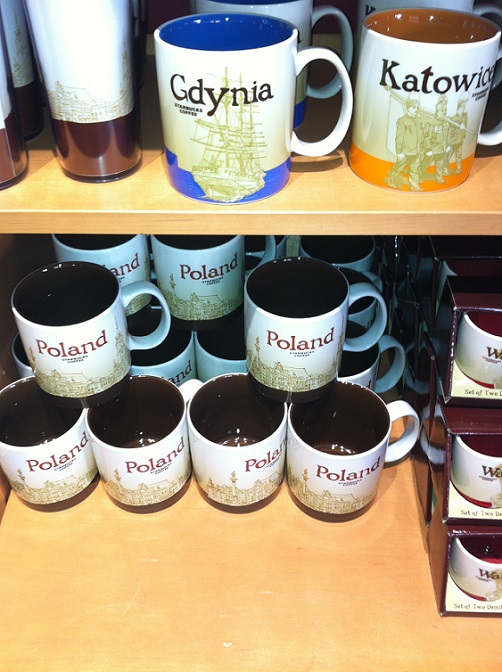
Starbucks Poland, the same as Starbucks anywhere.
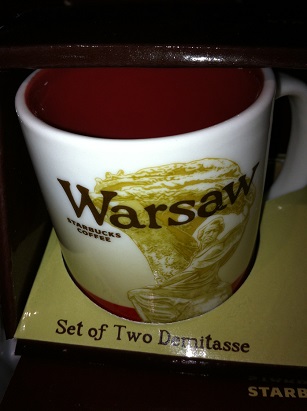
Warsaw, a modern city with several Starbucks branches
I close my eyes and I see Jews wearing long black coats, long beards and side curls, walking and talking in the street or coming out of the synagogue. I see old rabbis accompanied by their devoted disciples. I see signs in Hebrew and Yiddish advertising Kosher food and holy books.
Before "The War" about 395,000 Jews live here. During the war 400,000 Jews were crammed into the small ghetto area. Those images will never leave me.
But today there is Starbucks and the few Jews who remain can walk around freely...more or less.
The past and the present. I look for remains of the past, of what once was. I am fortunate to have my friend and student Tomasz as my guide; fluent in Polish and proud of his city. However not much remains of the past.
In May 1943 as the Nazis crushed the Warsaw Ghetto Uprising, they leveled the ghetto. That was the only way they could defeat the starved, badly outnumbered, outgunned Jews. The rest of Warsaw was destroyed by the German in August 1944 when the people of Warsaw with the Polish Resistance Homes Army, along with the remaining Jews, staged the Warsaw Uprising. By the end of the uprising the Germans had destroyed 85% of Warsaw.
Massive rebuilding began after the war. As a result of the destruction there is very little left of pre-war Warsaw, a wall here and there, part of a building. In fact I would say Warsaw is still very much under construction.
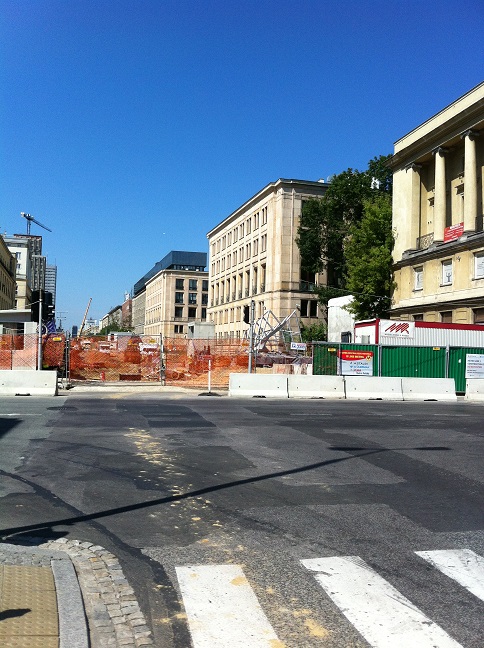
Warsaw under construction. Everywhere I went the city was under construction.
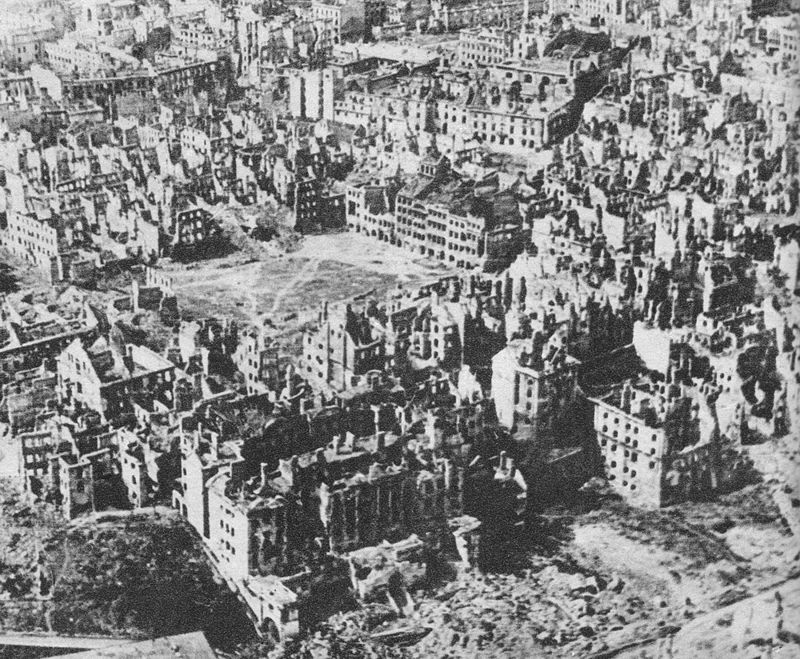
Warsaw destroyed, January 1945
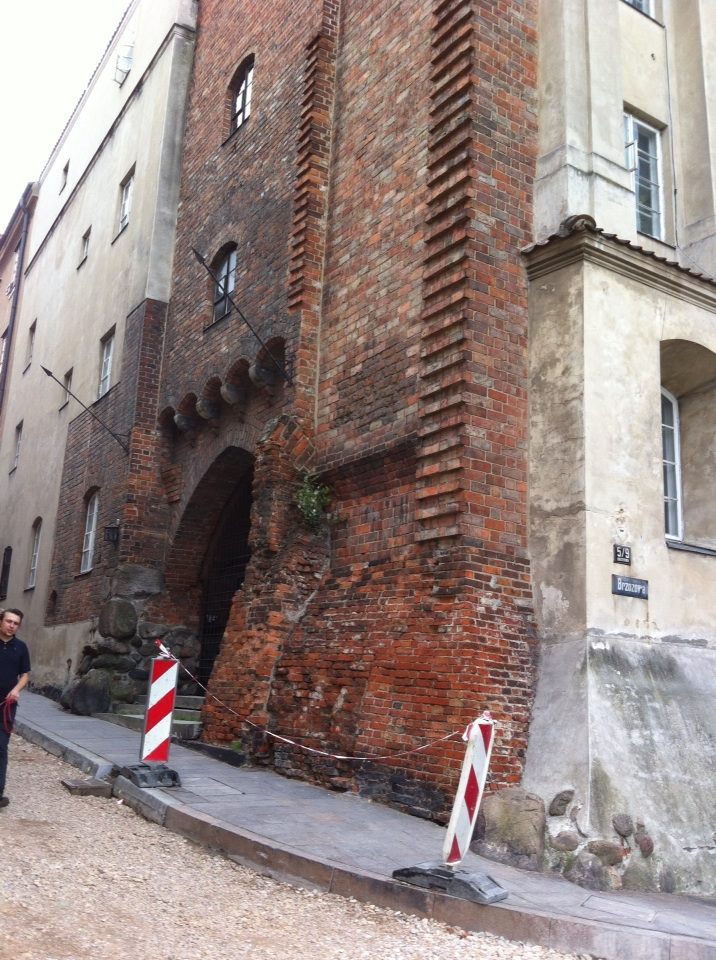
Warsaw 2014, wall remains from pre-war Warsaw
Back to the Warsaw Ghetto
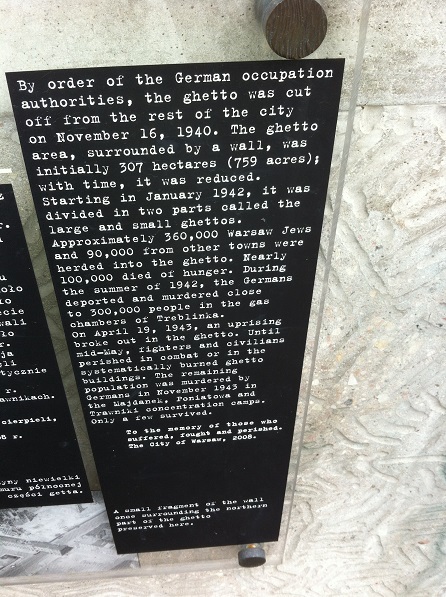
By order of the German occupation authorities, the ghetto was cut off from the rest of the city on November 16, 1940...
I looked for remains of the ghetto. I wanted to stand where my people stood. I wanted to be there. The Warsaw Ghetto still exists in my mind. The heroic little children are still being searched by the German soldiers as they are caught smuggling food back into the ghetto. The young Hasidic boy who refused to be separated from his father is still being shot, again and again, never ending, by the German soldier. I needed to be there with them.
I am thankful to the Polish government that a great effort has been made to preserve something of the ghetto, to mark where it was, to commemorate the suffering, the life.
Partially marking where the ghetto once stood there are now 21 border markings. This is a g "Ghetto trail". Developed with the help of the Jewish Historical Institute the markings show the boundary of the ghetto. Only in a few places do fragments of the ghetto still exist.
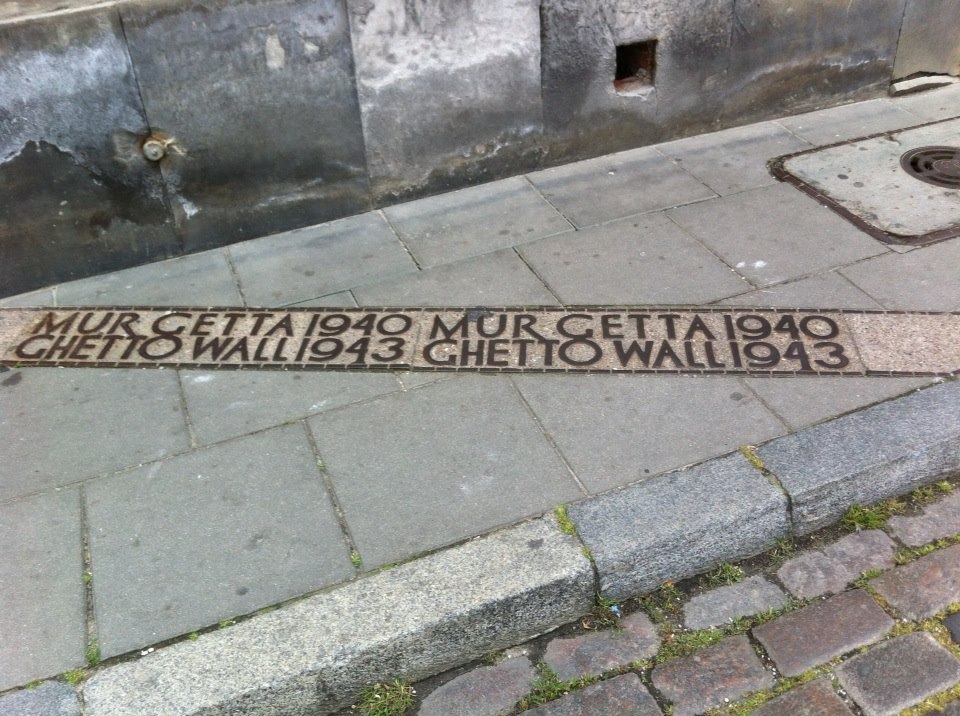
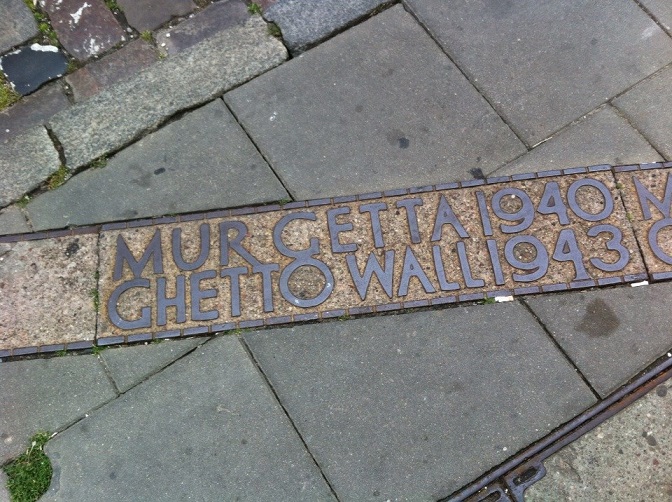
One side is inside the ghetto and the other side is outside the ghetto. One side meant certain starvation and death; the other side meant the possibility of life. To go from one side to the other was to cross oceans. The distance was small but those on the inside were locked in. It is incomprehensible that now one can just walk over, from one side to the other, the Germans guards are gone, the dogs are gone, the terrifying barking and shouting and random killings are gone, the guns are gone.
I close my eyes and on the inside I see children lying down and dying from starvation. I see old Jews walking around half dead. And then I open my eyes and I see young people on bicycles, freedom has returned, but for some it is too late.
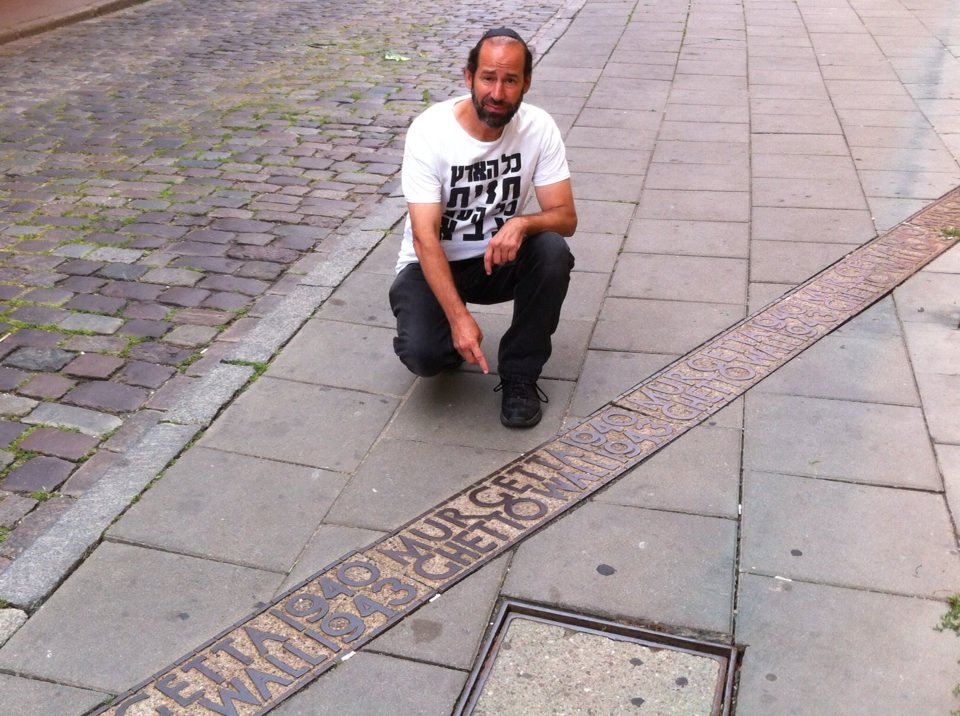
Moshe inside the ghetto. I cannot describe the feeling. How many Moshe's stood here in this spot and dreamed of being free? How many of our Jews walked here but soon died? I am inside the Warsaw Ghetto, the place I have seen in my fantasies since I was a small child. I dreamed of going back in time and bringing help to these people. It is unfathomable to me how now one can just casually walk over this marking whereas once it was the marking of life or death. Inside the ghetto I am with my people.
Remains of the "Small Ghetto"
The area south of Chlodna street was known as the "Small Ghetto" and was loosely connected to the main area of the ghetto. In 1942 the ghetto was reduced in size and the small ghetto became "Aryan"; thus, it survived the Warsaw Ghetto Uprising but most of it did not survive the Warsaw Uprising of August 1944.
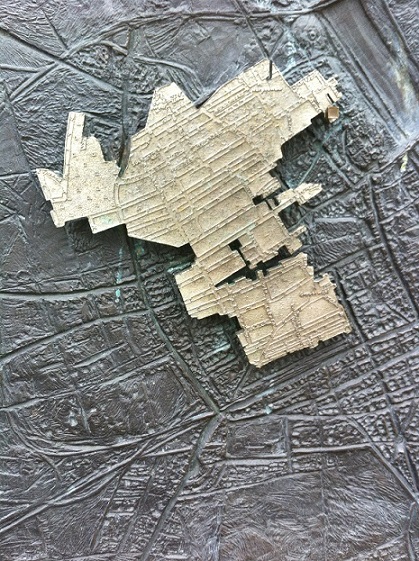
Stone map of the Warsaw ghetto. Today this appears at the location of the one of the former ghetto walls. The lower part, separated by a small Aryan segment, was known as the "Small Ghetto", in 1942 the ghetto was reduced in size and this part became Aryan.
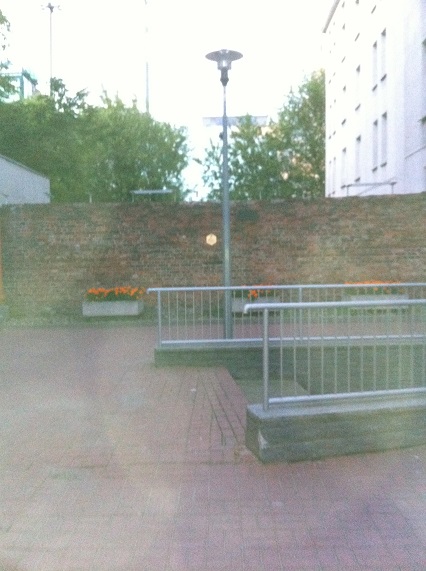
An original segment of the wall dividing the "Small Ghetto" from the rest of Warsaw. Today it is part of a residential neighborhood and part of the area where children play and cats hang out. It is also a place of pilgrimage for visitors from all over the world, including of course from Israel.

The southern part was called "The Small Ghetto".
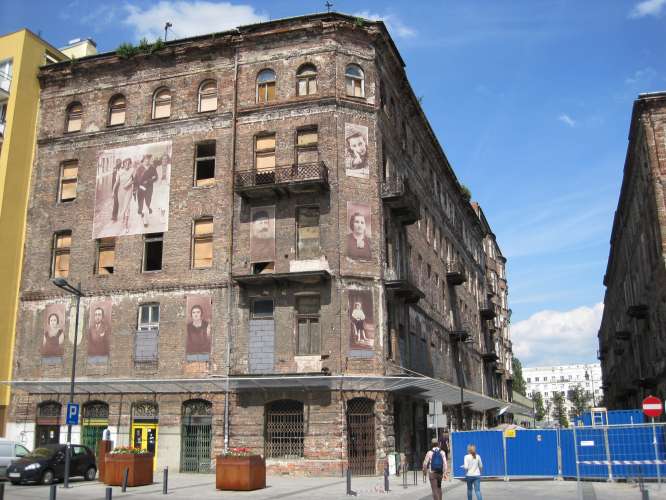
Próżna Street, Warsaw.
Photograph taken a few years ago. Sadly, it was apparently decided that after all these years the property was too valuable to be abandoned and recently these buildings have been renovated, from the first time since the war. I was still able to catch a little glimpse of what it looked like in 1941 when it was part of the ghetto and poor desperate starving Jews lived here.
In this photo are featured large photographs of Jews who had lived in Warsaw at that time. "Members of the disappeared Jewish community.
A visitor in 2011 advised people to come soon as it will all soon be renovated and gone...at least I was able to see something and imagine...
Bullet holes can be found along some of the walls and at one end are photographs of people who may have lived on the street...close your eyes and just imagine what stories that street can tell...
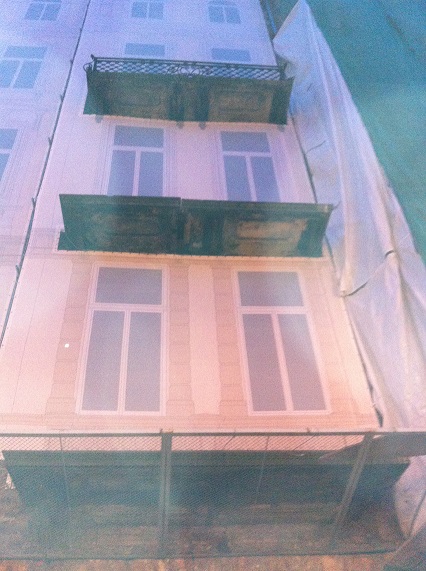
Próżna 14 currently under renovation, we can still see the famous balconies that we know from photos of the Warsaw Ghetto.
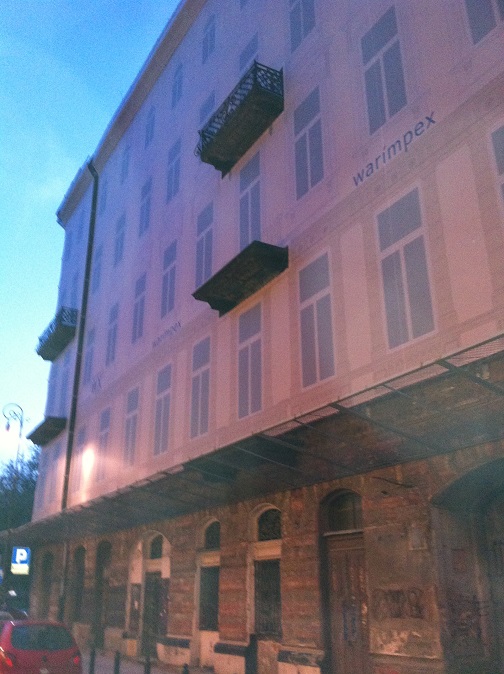
The original balconies can still be seen as well as the first floor. This is how it was left since the war. Soon nothing will be left of it to see but for now we can imagine what it was like when Jews lived here during the German occupation. I can imagine their faces, their hunger, their fear. This is where they lived; families, children lived in this very building. From here they were taken to the deaths.
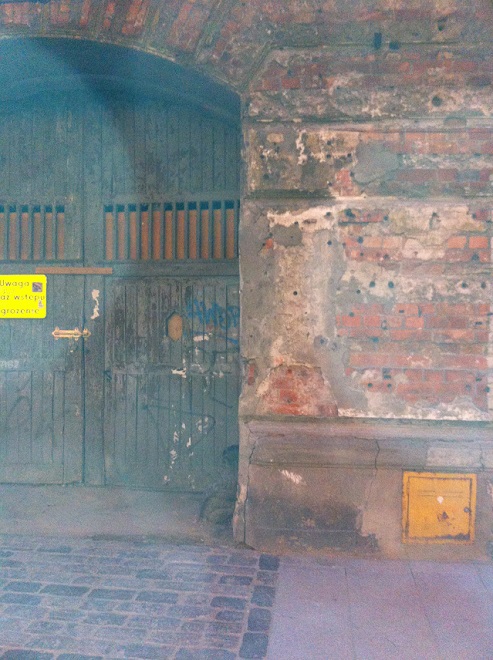
Próżna 14 first floor, exactly as it was during the period of the Warsaw Ghetto. Like going back in time, we just need to open our souls and see the spirits that live here. Open our hearts and see the children crying for food.
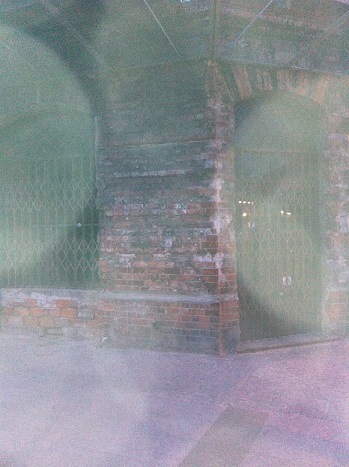
Próżna 14 corner.
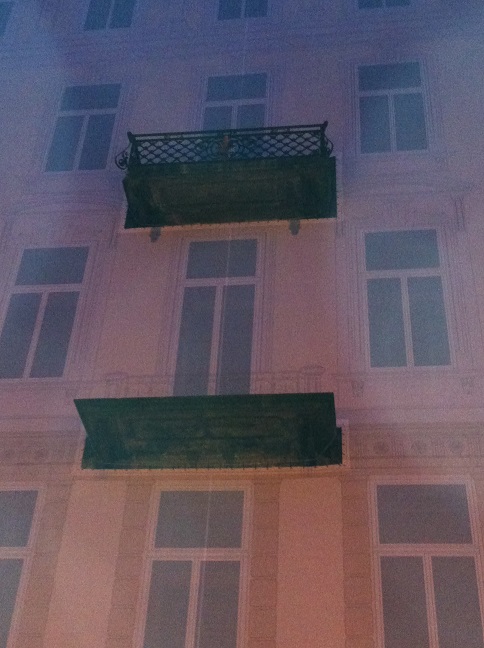
The details of the balcony match the memories I have of the Ghetto.
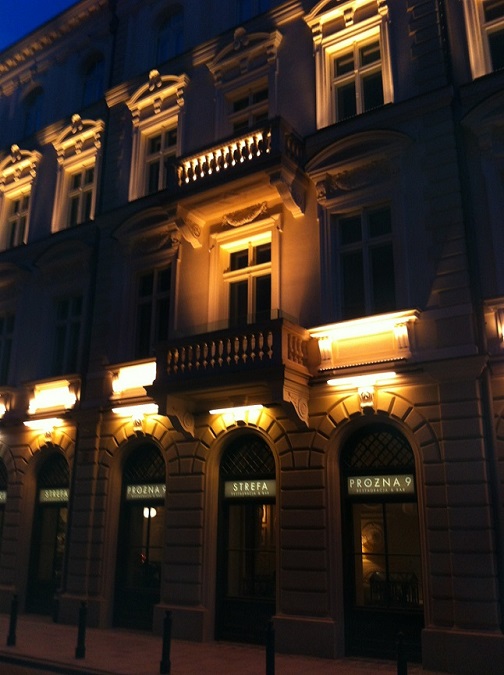
Próżna 7-9, sadly has been renovated, the bottom floor is a restaurant and the rest of the building is used for office space. Yet, it is the same building as it was during the war. Do the current inhabitants feel the presence of those whose horrible fast was sealed here?
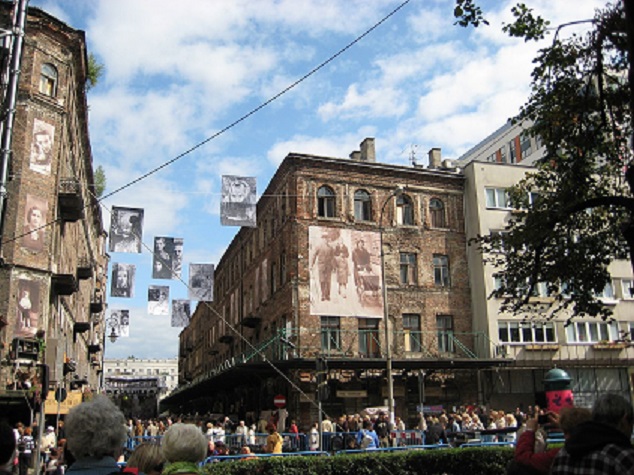
Próżna 7-9 and 14 before the recent renovations.
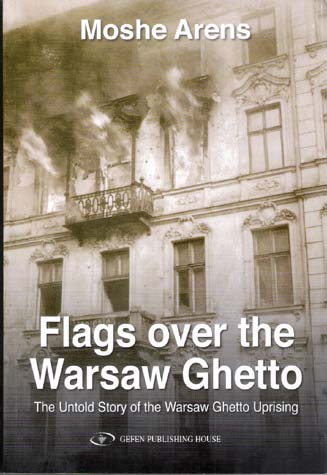
Cover photo from the book by Moshe Arens, you can see the ghetto architecture.
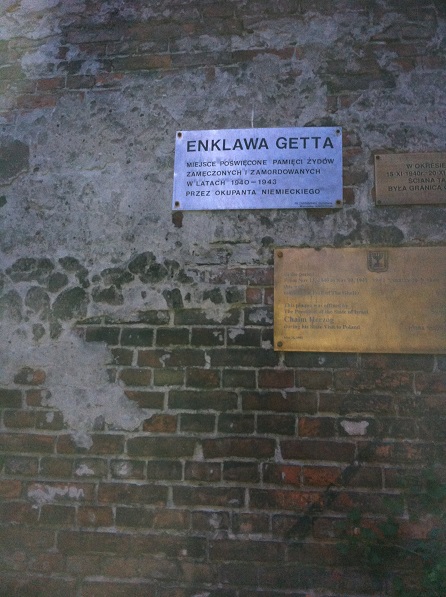
A segment of the Small Ghetto wall, with plaques including one from the president of Israel who visited here himself.
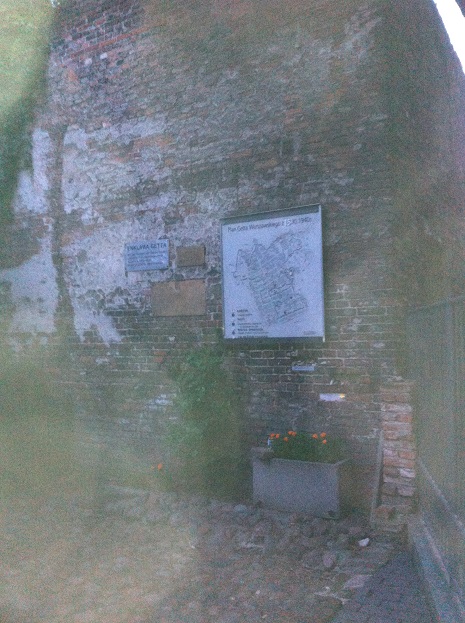
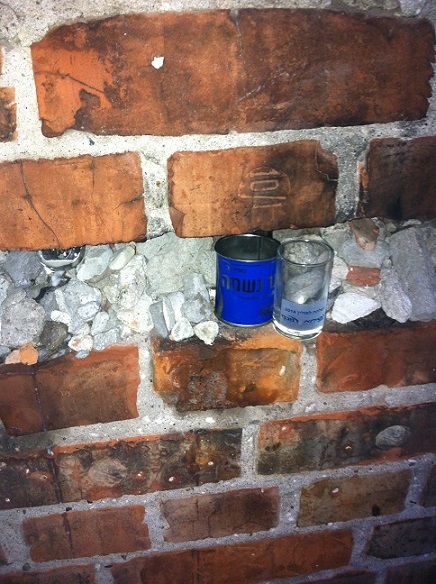
A small remaining segment of the wall surrounding the "Small Ghetto", people have left Jewish memorial candles to honor the souls of the victims.
Umschlagplatz
Few words bring to mind the fear, dread and panic that the word Umschlagplatz does. This was the place the Jews of the Warsaw Ghetto wanted to avoid more than all, for it meant deportation and death.
At this site more than 300,000 Jews were forced into overcrowded freight cars and sent to the Treblinka Death Camp.
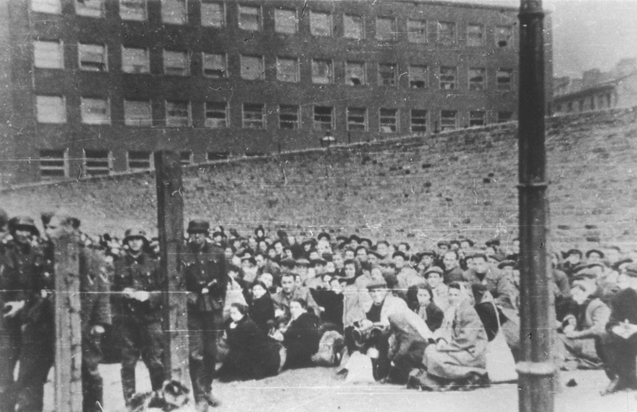
The Umschlagplatz during the years of the Warsaw Ghetto; Jews being guarded by Nazis and waiting to be sent to their death.
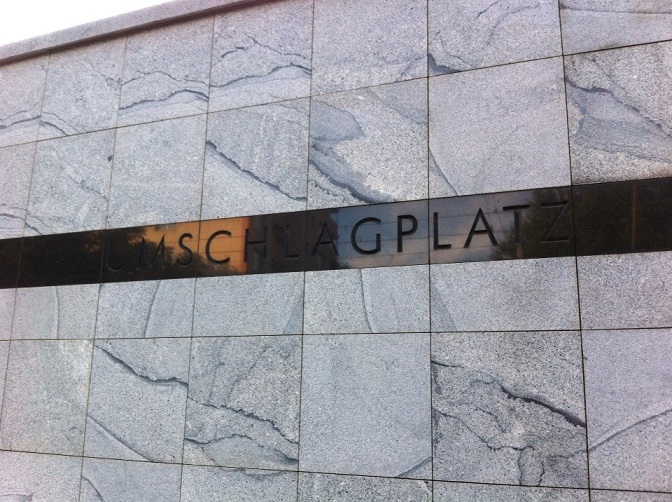
Monument to the Jews who were deported from this dreaded spot. Umschlagplatz; concentration point.
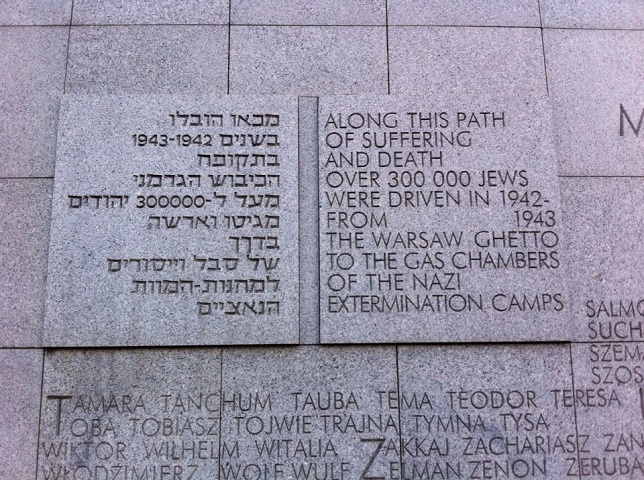
We believe in names, a name is a person, an individual. We want to remember all the names, all the people who suffered and died. But too many were rounded up here for death to mark all their names. There is no room to carve out 300,000 names. So in alphabetical order the most popular Polish-Jewish names are listed; Tamara, Tanchu, Tauba, Tema, Teodor; each one representing so many real people, who were here, at this spot, waiting to be deported to their deaths, but still hoping perhaps for a miracle.
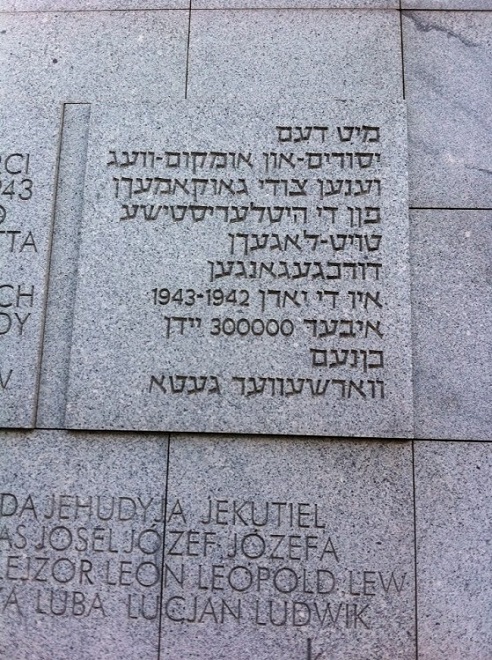
Inscription in Yiddish, and more common Polish-Jewish names.
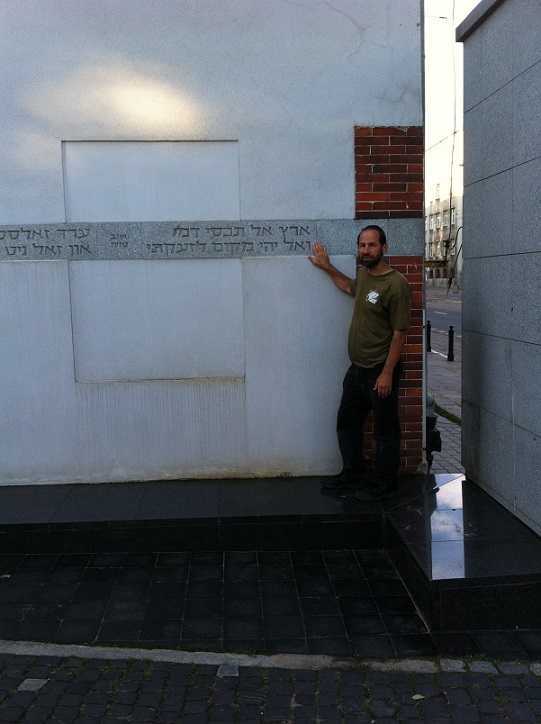
Moshe at the Umschlagplatz, standing where so many of our people stood terrified awaiting the trains to the death camp Treblinka and other death camps.
Here the Warsaw Ghetto Uprising began as the fighters tried to stop the deportations.
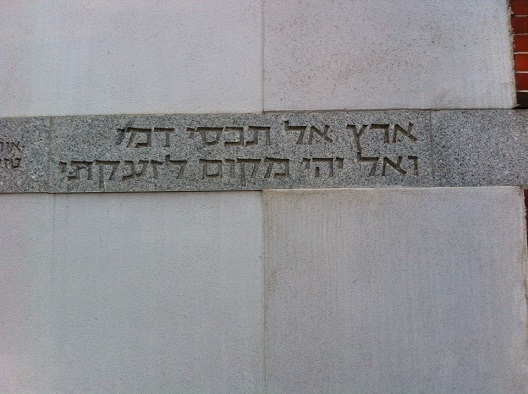
"Land, Earth, cover not my blood, do not hide my blood, do not hide the evil and the crime that was done to me but rather let it be seen to all so that all should know. Let there not be a place for my screams to be hidden. " (Job, chapter 16, verse 18)
These monuments are so that the blood of our people should not be covered up and their memory never lost. We stand here and we hear their cries to heaven, their prayers...that sadly were not fulfilled. We stand here and we try and feel their trembling, mothers holding on to terrified children, men and women with canes in the twilight years of their lives wondering what the day will bring, people that deserved better, to end their lives in dignity...being barked at and shouted at, shoved into trains to.....The Station Treblinka!
Earth, cover not my blood, let there be no place to hide my scream. Here they stood and we stand with them. Remember their names.
Mila 18
On April 19, 1943, the remaining Jews of the Warsaw Ghetto realized the end was near. Soon the deportations would destroy the last remnants of this once proud community. The last Jews knew that the Germans planned to deport the remaining Jews to the Treblinka death camp.
There was no expectation of survival, only to offer resistance, to die fighting. They left a mark on the Jewish people and on the world that is still felt strongly and powerfully today.
Of the 400,000 Jews who had been packed into the ghetto less than 50,000 remained. Of these less than a thousand were actual fighters.
The Jews were divided along political lines into different fighting groups, but the commanders and the two groups worked together and coordinated their actions.
The better known of the two groups was the Jewish Combat Organization. In Polish Żydowska Organizacja Bojowa; and known as ZOB. This group was led by the legendary Mordechai Anielewicz.
The other fighting group was the Jewish Military Union, in Polish, Żydowska Zwiazek Wojskowy; ZZA.
The ZZW is lesser known as none of its commanders survived the war and thus the story was only brought to the public recently. An excellent account of their actions and contributions can be found in Moshe Arens' book, Flags Over the Ghetto.
The leader of the ZZW was Pawel Frenkiel (same family name as one of the three Israeli boys recently abducted and murdered).
Pawel Frenkiel was born in Warsaw, where I am at this very moment, but little is known about his life other than the fact that at age 18 he joined the Betar Zionist Jewish youth movement. It is not known exactly when he was killed but it is believed he was killed at 7 Muranowski Square. (7 Muranów Square)
The story of Mordechai Anielewicz is better known and there is no doubt as to his greatness and his impact.
Anielewicz was born into a poor Jewish family in the small town of Wyszkow near Warsaw. He joined the Shomer H Tzair he left wing Zionist youth movement.
We all grew up with this legendary poetic words that still ring in our ears:
"Be well, dear friend, Maybe we will see each other some day. The main thing: the dream of my life was realized. The Jewish Self-Defense in the Warsaw Ghetto became a fact. The armed Jewish struggle and the revenge became a reality. I am a witness to this grand, heroic battle of the Jewish fighters." (Letter to Yitzchak "Antek" Zuckerman, April 23, 1943)
The Jewish groups also received help and support from the Polish resistance movements; the Polish Home Army Armia Krajowa, and the Communist Polish Workers Party, the Peoples Guard, Gwardia Ludowa.
The heroic exploits and super human fighting of the ghetto is too great a story to be told here. But for nearly a month the Jewish resistance fighters fought back the German war machine day after day until the ghetto was destroyed block by with fire and gas.
From the rubble Jews continued to fight for two months. Others escaped to the forests and joined the partisans while some stayed in Warsaw and joined the Warsaw Uprising of August 1944, a heroic story all its own.
Far from going easily to their deaths these Jews fought at every opportunity on every front. A handful lived to fight again for the free state of Israel. Their heroism kindles our souls to this very day. I stood where these great men and women once stood. I stepped in their holy and hallowed footsteps. It was a pilgrimage of a lifetime.
The hour was getting late and my guide was more than patient, but I had to find Mila18. As it turns out it is really pronounced Miwa.
Mila 18. the legendary headquarters of Mordechai Anielewicz, the bunkers, the fighters. The Nazis found them on May 8, 1943, it was all over. Some took their own lives, some escaped. Many died of gas, they died at Mila 18.
Mila 18, the great symbol of Jewish resistance and bravery. Today we have the Israeli army, proud and free, but then in these underground bunkers we had fighters no less brave, no less fierce, fighting under the worse possible circumstances. Mile 18; Heroes!!!
When Tomasz said we were close, I became very excited. Could it be? Could I be in the vicinity of heroes, this is where it all happened. We found Mila street and we found number 18 but...it did not look or feel like this was the place. It just did not fee right. I knew something was wrong.
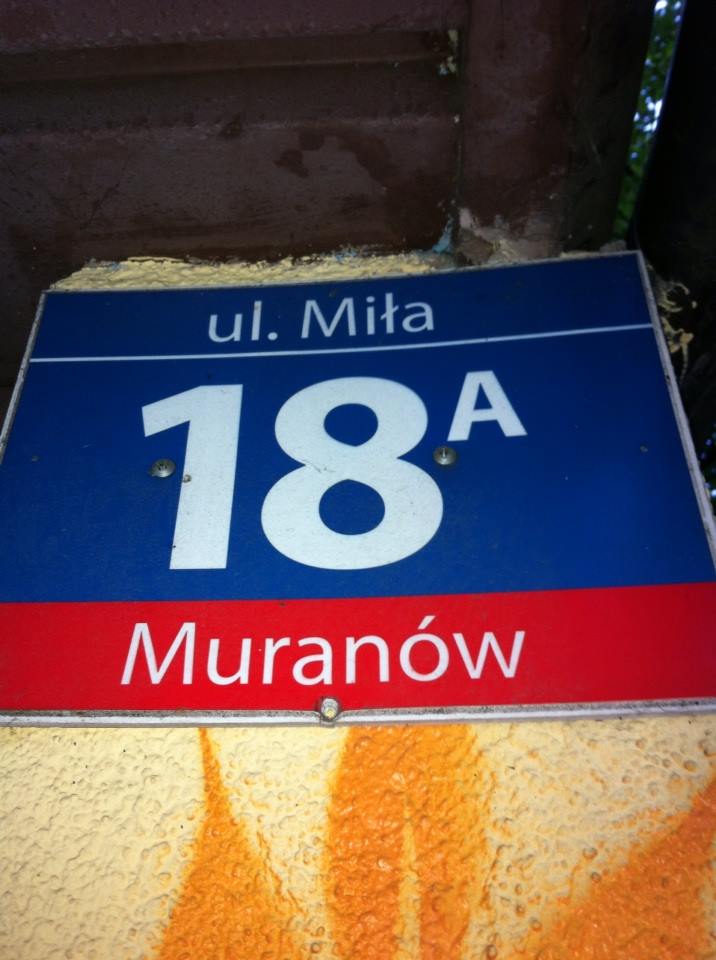
Mila 18. We walked into the corner grocery store. Could these people possibly know where the bunker was? I asked Tomasz to ask around. Lots of Polish, I understand a word here and there and I can see that no one really knows. It was a long time ago, now this is a quiet residential neighborhood and people just want to buy some food.
Finally we find a woman who is very animated, she knows! Yes, she knows, her father told her about it. But it is not here. After the war the street was extended and began much earlier, thus the numbers started earlier and current Mila 18 that we found is not the place of the bunker. The original address is now a much higher number and is further up the road. "Keep going" she tells us, "and you will find it."
We keep going but we reach a highway. We have come this far, it is getting late but I cannot stop. We cross the highway and continue walking. Still nothing in sight. Just a quiet peaceful neighborhood. We see a woman walking, perhaps she knows.
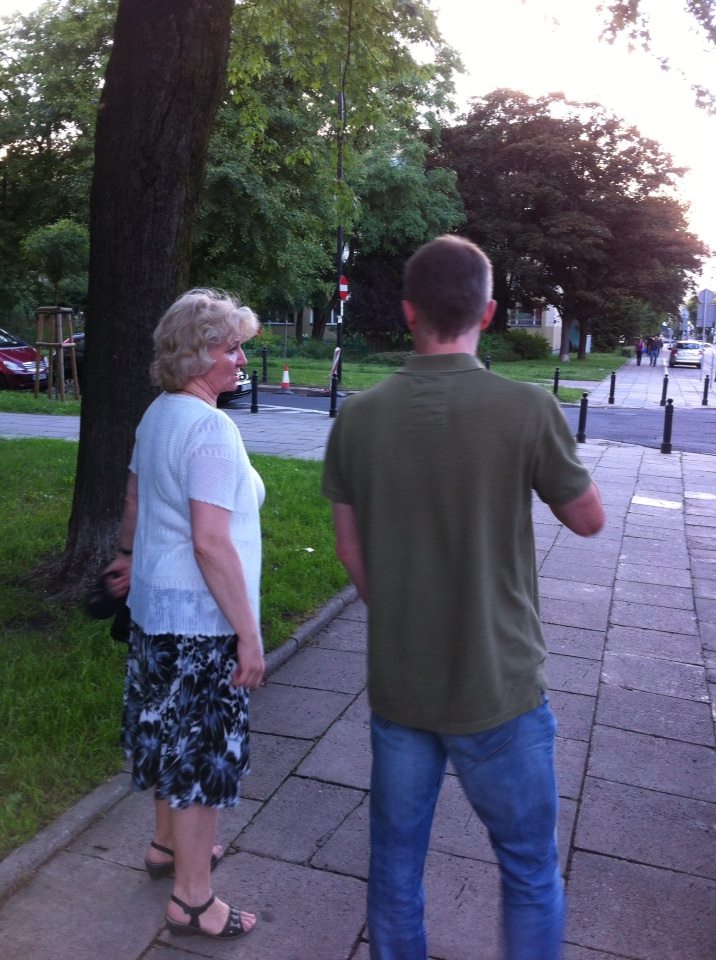
Tomasz asking a local woman about the location of the destroyed Jewish resistance headquarters. Yes, she knows, keep going...
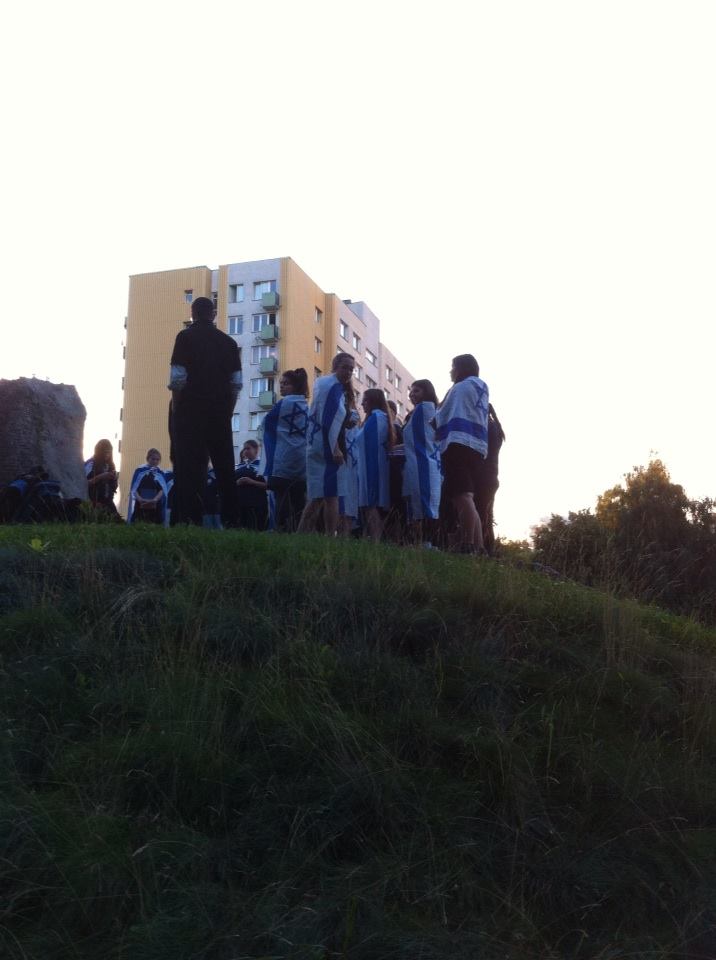
We did not have to look much further. Just a few more steps and I hear singing, crying... Jewish sounds, Jewish songs. I told Tomasz look no further, we are here. We follow the sounds and soon see the Israeli flag, many of them, on top of a small mound. I recognize the sounds; sounds of pain, sounds of deep pain, Jewish sounds. We hurry up to the small mound and on the hoodies I see "Journey to Poland" and the symbol of the Bnei Akiva, Orthodox Jewish youth movement.
It is a group of teenage Jewish girls from the Zionist Orthodox youth movement in Australia and South Africa along with their two adult male leaders. They are on a pilgrimage.
Tomasz cannot believe it, he cannot understand, he keeps repeating , "they came from so far away!"
But I understand, of course. For here at Mila 18 and here in Poland lies so much of our world, our world that was destroyed, our world that no longer exists. They came from afar, as did I, to pay respect, and to be inspired. To stand where these great warriors stood, fought, and ...died.
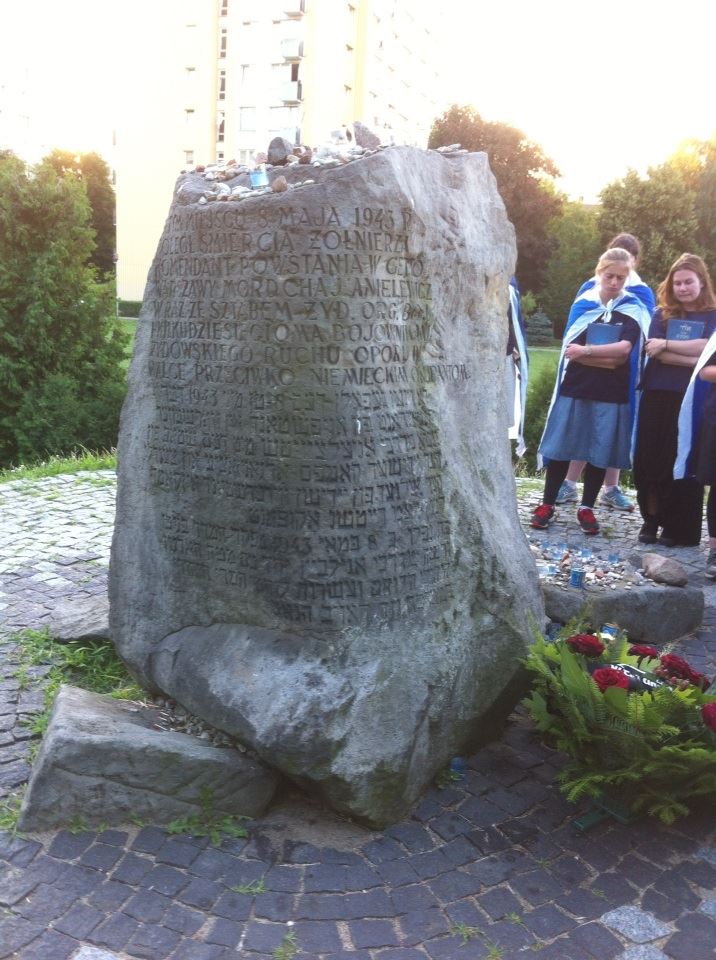
Members of the Zionist youth organization of South Africa and Australia mourn at the site of the bunker. The stone is made of rubble from destroyed houses of Mila street.
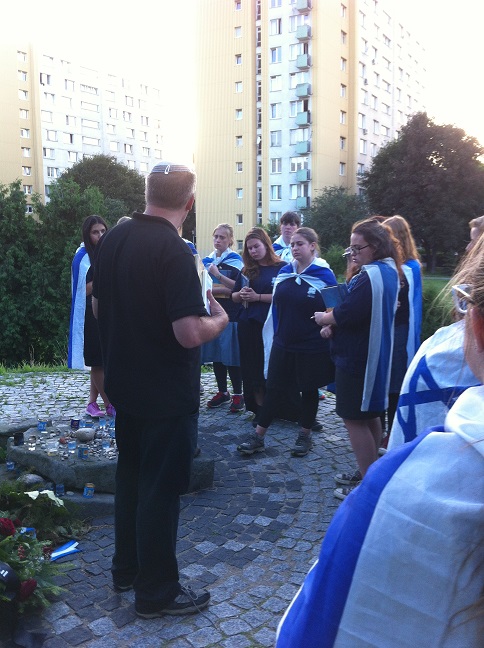
Respect
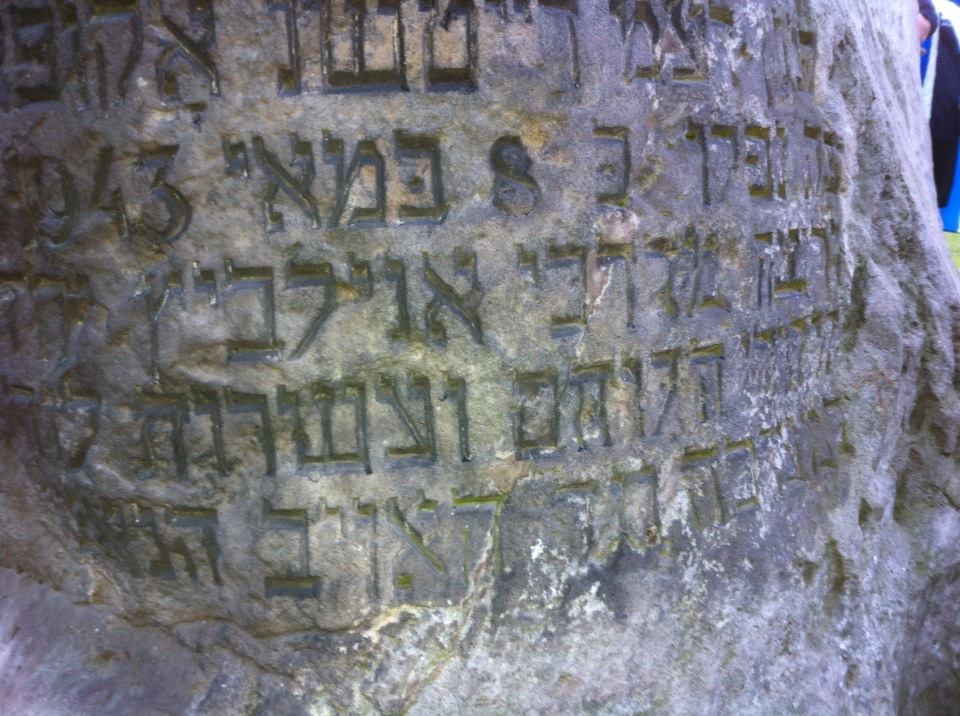
Carved in stone made from the rubble, the name in Hebrew...Mordechai Anielewicz and "dozens of Jewish fighters"
What I did not realize, that I never thought about, was that the fighters are still here! I read the monument and I understand that Mordechai Anielewicz and the great Jewish fighters are still here.
Here they were buried under the rubble. Here they fought, here they raised hope, and here they died. Their spirit is all over the Jewish world, it is with the IDF fighters of today, i tis on the border with Gaza and the border with Lebanon, but it is also here. Here they lie!! Here!!! I am so close to them, my heroes, my inspiration, the Warsaw Ghetto Uprising that goes down in our long history along with Masada and the great struggles of our won time, I am here, I am with them, my brothers and sisters.
My father of blessed memory always told us, on the even of the first night of Passover the Jews arose against the powerful Nazi death machine...on the festival of Freedom our people rose in the name of glorious freedom...
And now I stood with these great men and women.
So many times I stood in Yad va Shem in Jerusalem and saw their photos, read their words and heard their stories recounted by survivors, by those who knew them, but now I am here. I am touching them. There are no words. Rest well my friends, your struggle was not in vain for today thousands, many thousands walk in your holy footsteps. A powerful army knows your story. You are now commanding a great and powerful force as our Dry Bones have come to life, as you dreamed it and as our prophets of old prophesied.
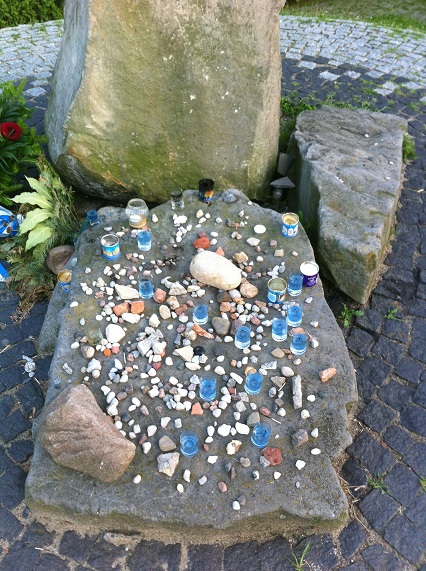
Memorial candles and stones; Jewish tradition to show that someone visited the grave.
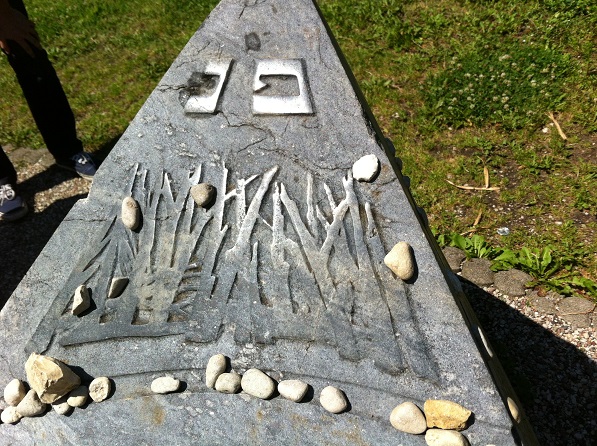
Traditional Jewish marking of a grave. The grave of the warriors of Mila 18.
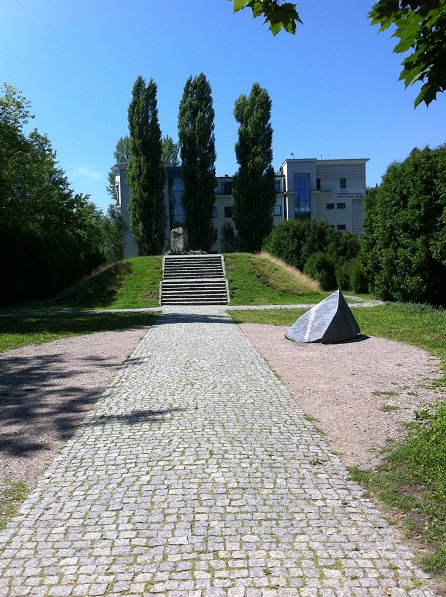
Here was the bunker, here lie the stones that were once part of the bunker and here the warriors rest peacefully. Thank you to the city of Warsaw for not building on this prime peace of real estate. The memory of the fighters is being honored.
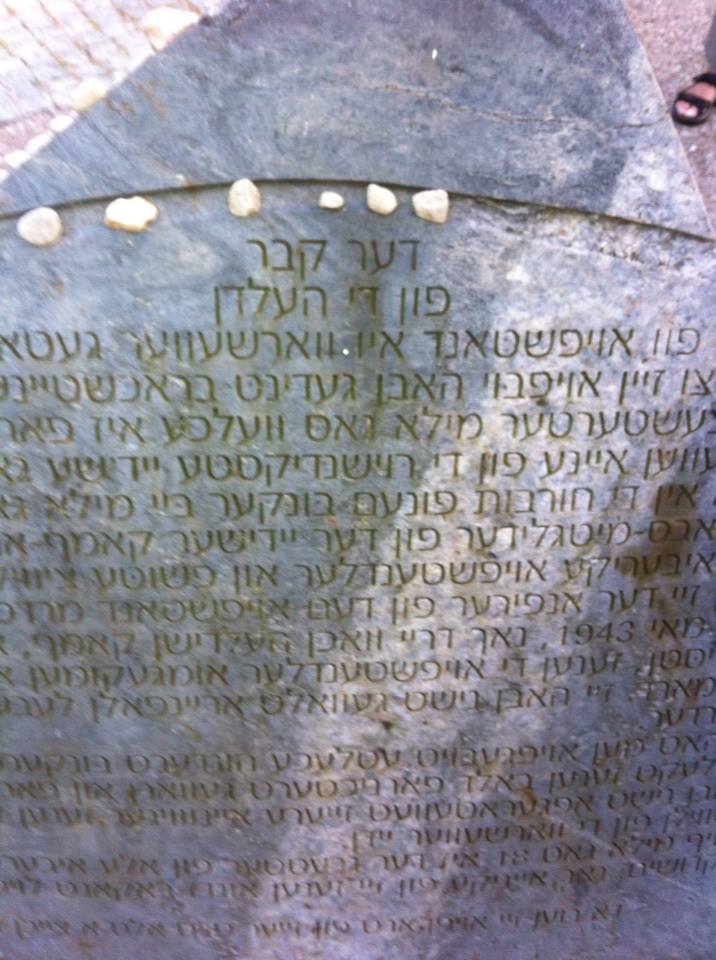
Stone at the site of the bunker at Mila 18. Written in Yiddish, the spoken language of the Jews in Eastern Europe. It tells the story of the ruins of the bunker, the graves that are there and of the Warsaw Ghetto Uprising.
The bodies of the Jewish fighters were no exhumed after 1945. Gradually the place gained a status of a war memorial.
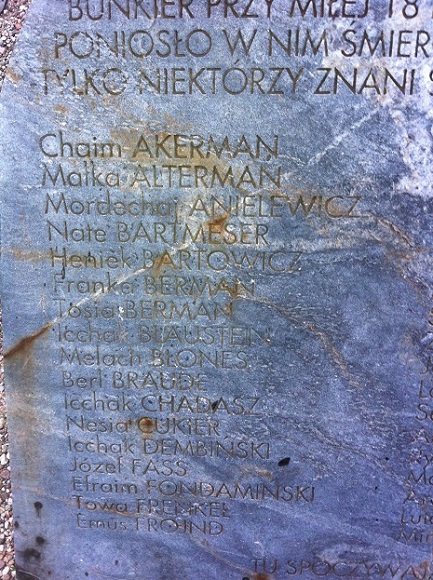
Names of some of the fighters who died on this spot May 8, 1943
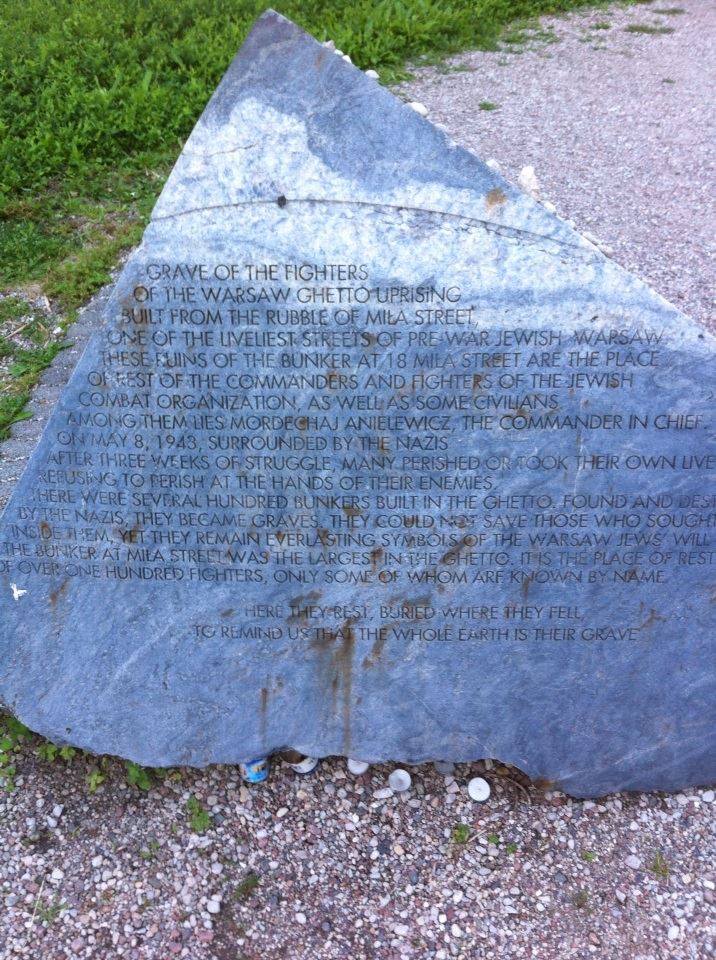
Grave of the Fighters
Grave of the fighters of the Warsaw Ghetto Uprising built from the rubble of Miła Street, one of the liveliest streets of pre-war Jewish Warsaw.
These ruins of the bunker at 18 Miła Street are the place of rest of the commanders and fighters of the Jewish Combat Organization, as well as some civilians. Among them lies Mordechaj Anielewicz, the Commander in Chief.
On May 8, 1943, surrounded by the Nazis after three weeks of struggle, many perished or took their own lives, refusing to perish at the hands of their enemies.
There were several hundred bunkers built in the Ghetto. Found and destroyed by the Nazis, they became graves. They could not save those who sought refuge inside them, yet they remain everlasting symbols of the Warsaw Jews’ will to live. The bunker at Miła Street was the largest in the ghetto. It is the place of rest of over one hundred fighters, only some of whom are known by name.
Here they rest, buried as they fell.
The names of 51 Jewish fighters whose identities have been established by historians are engraved on the front of the obelisk.
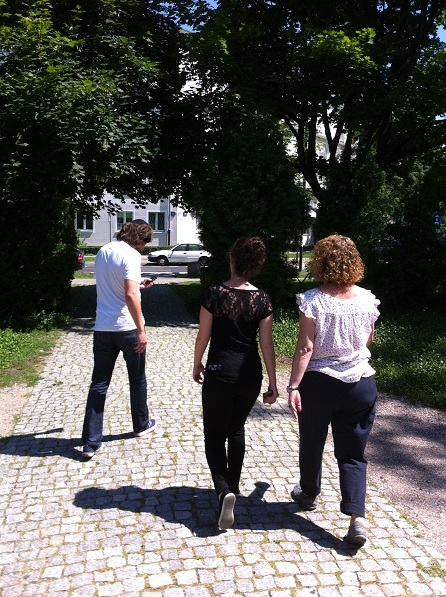
Tour guide, local Polish Jew, with two Israeli visitors who came to pay their respect to the legendary fighters.
Mila 18, however, was not the only site of Jewish resistance and command. We cannot forget Pawel Frenkel. There is a marking of his bravery somewhere in Warsaw. Little did I know it is right outside of Mila 18, I would find it only the next day.
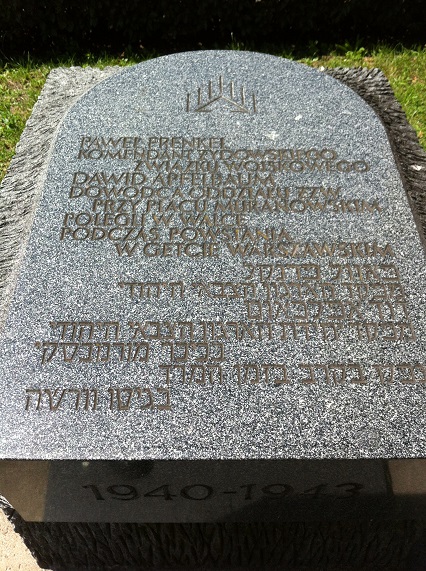
Pawel Frankel has no grave but this stone commemorates his life and bravery. Written in Polish and Hebrew. David Apfelbaum is also honored here.
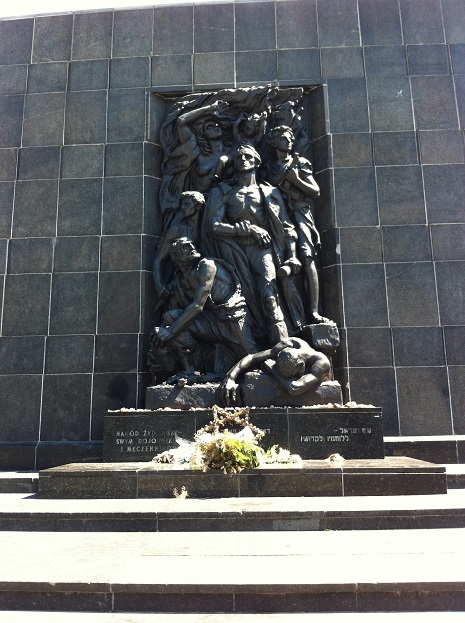
Memorial to the Warsaw Ghetto Uprising, same as in Yad Va Shem in Jerusalem.
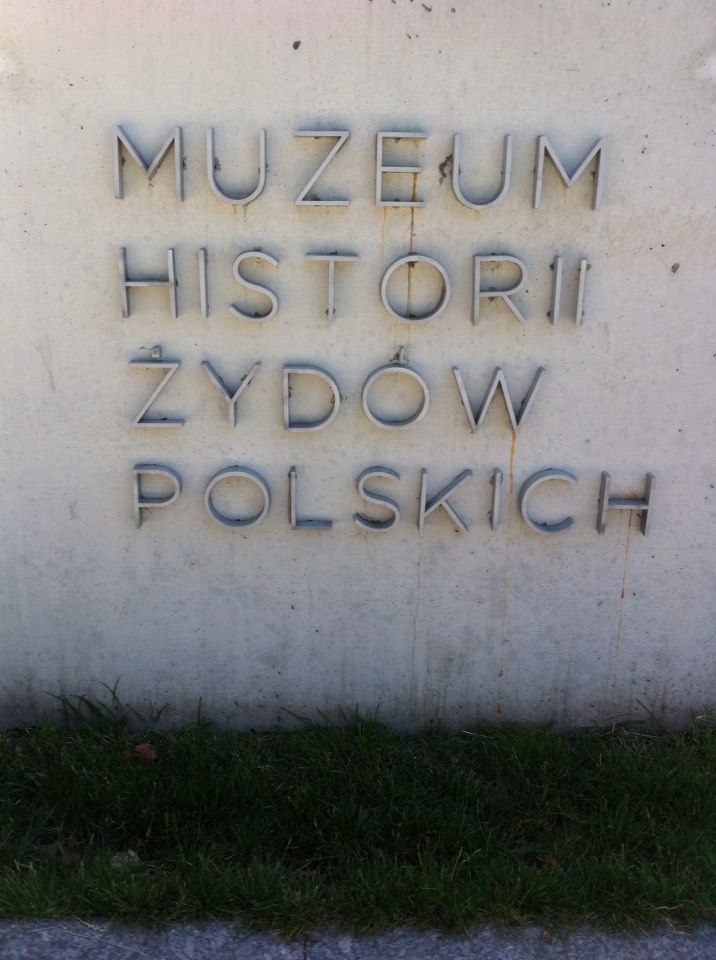
There is a huge museum of Polish Jewish history here in Warsaw. There is a tremendous effort to reclaim the past, including the glorious Jewish Polish history. But do the young people of today, drinking their Starbucks coffee and enjoying life understand that "Warsaw's pre-war Jewish population in 1939 was 393,950 Jews, approximately one-third of the city total."
It is difficult to imagine, this thriving city was once the home of so many Jews and today there is hardly a trace. .
That night I saw something amazing. Sitting with Tomasz at a coffee house next to Starbucks, as Starbucks closed at 9 pm on a Sunday night, I saw three men, 30 somethings, with Kipot/yarmulkes on their heads, Jewish head coverings. I acknowledged them with a smile from a distance, figuring like me they must be tourists.
As they came out I walked up to them and said hello, best not to be shy. I was mistaken, they were not tourists and in fact did not even speak English. They were actual Polish Jews whose families never left this region. They are remnants of the once great Jewish community of Poland. I felt like I was touching a relic saved from the fire.
I cannot describe the feeling of brotherhood that I felt. These people represented something unspeakable, like meeting dinosaurs that somehow survived to the present day. One held a book in his hand, a guide to studying Hebrew.
It was like meeting a long lost relative whom you no longer knew that was alive.
They told me of Jewish life in Warsaw, how each year 20 -30 new members join the synagogue, how Jews are coming out openly as Jews, how others are discovering their Jewish roots. They said they experienced only minimal antisemitism, mostly from stupid young people. otherwise, nothing. They lived freely in Warsaw. Today they said there are only about 2,000 Jews in Warsaw.
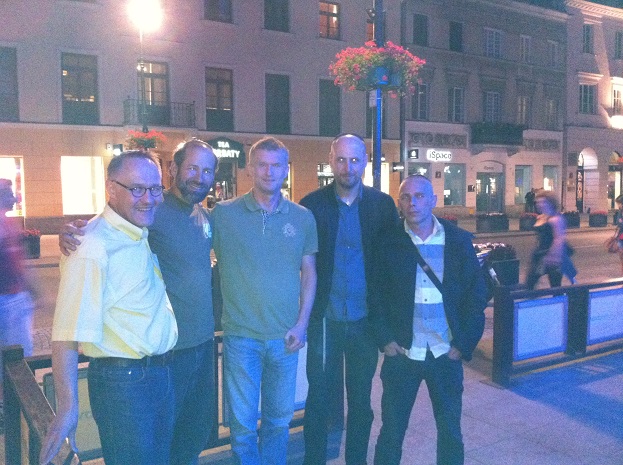
Moshe, Tomasz, and some local Jews, new friends. Downtown Warsaw.
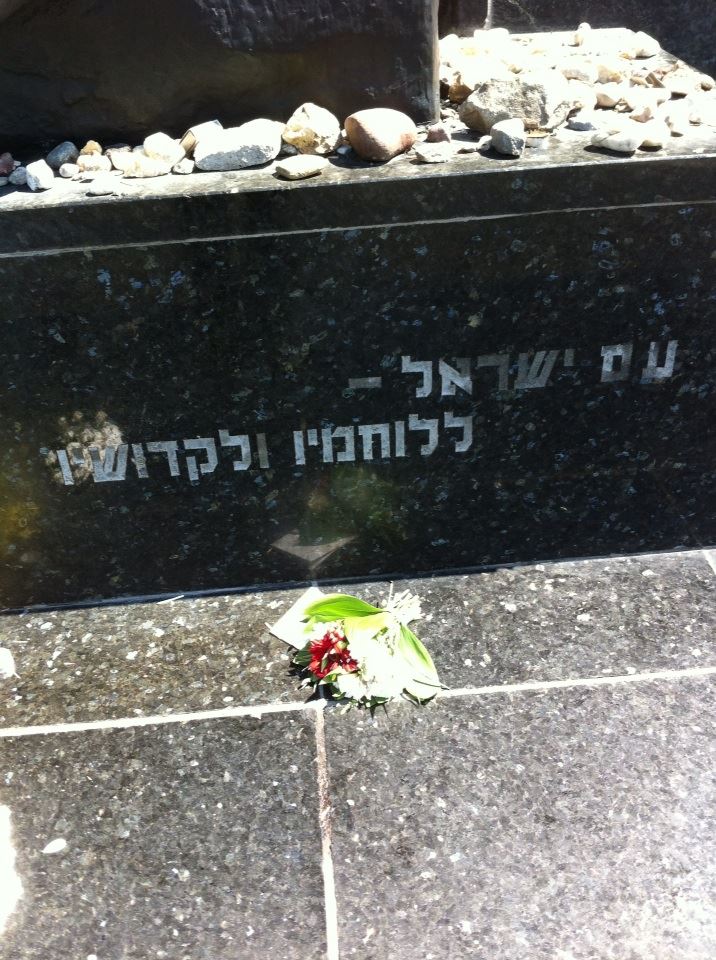
Am Yisrael , the Nation of Israel, to its fighters and holy martyrs. Warsaw Jewish museum.
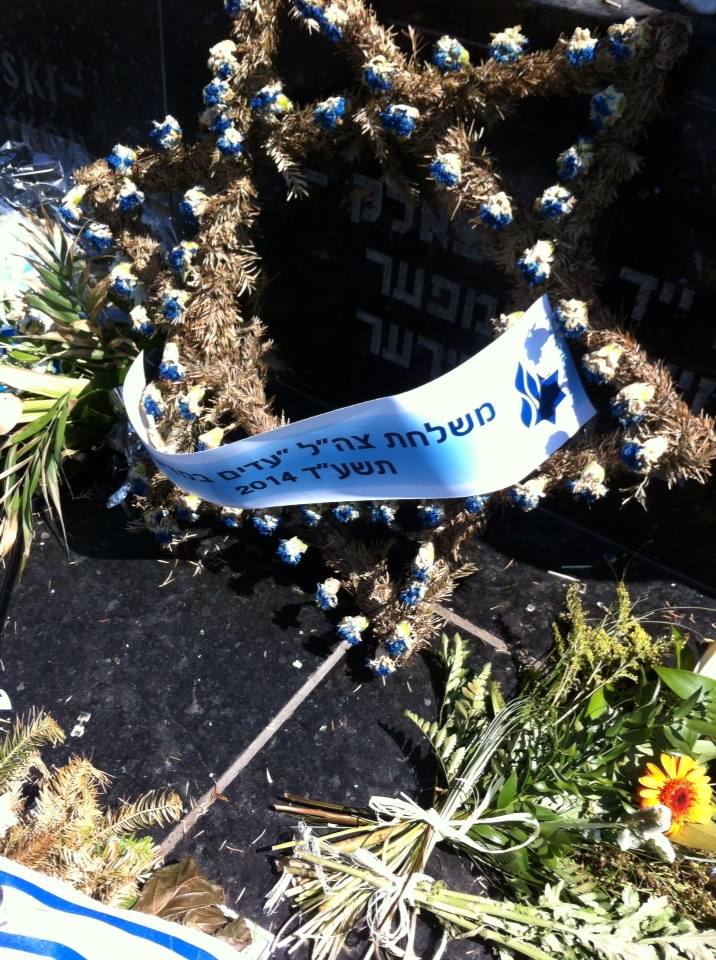
Flowers left respectfully by "Israeli mission; Witnesses in Uniform", Israeli soldiers and police officers who come to Poland to honor the Jewish past and to witness Auschwitz and the death camps. I had the honor of meeting this group at Birkenau.. One of the soldiers recognized me and came up to speak to me. "You recently lead a large group of Krav Maga students at Yad Va Shem?
He had seen me with our Tour and Train group and was quite impressed. Now he asked me about my mission. I said just as the Israeli army and police force feel that their soldiers and officers must come to Poland and understand the Jewish history for themselves I feel that Krav Maga students must understand Israel, the Jewish people, and the Holocaust to truly become Krav Maga instructors, to understand who we are.
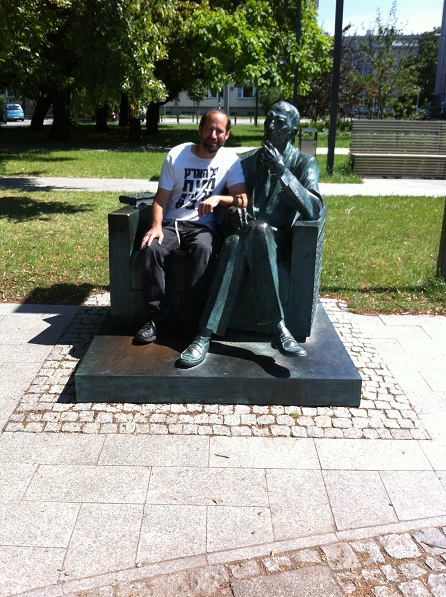
Moshe with the great Jan Karski.
July 15, 2014
One more stop to visit the Nozyk Synagogue. I was here earlier for the Shabbat prayers. I followed the directions and was within feet of the synagogue when I saw the sign Jewish Theater. But I was not certain exactly where the synagogue was.
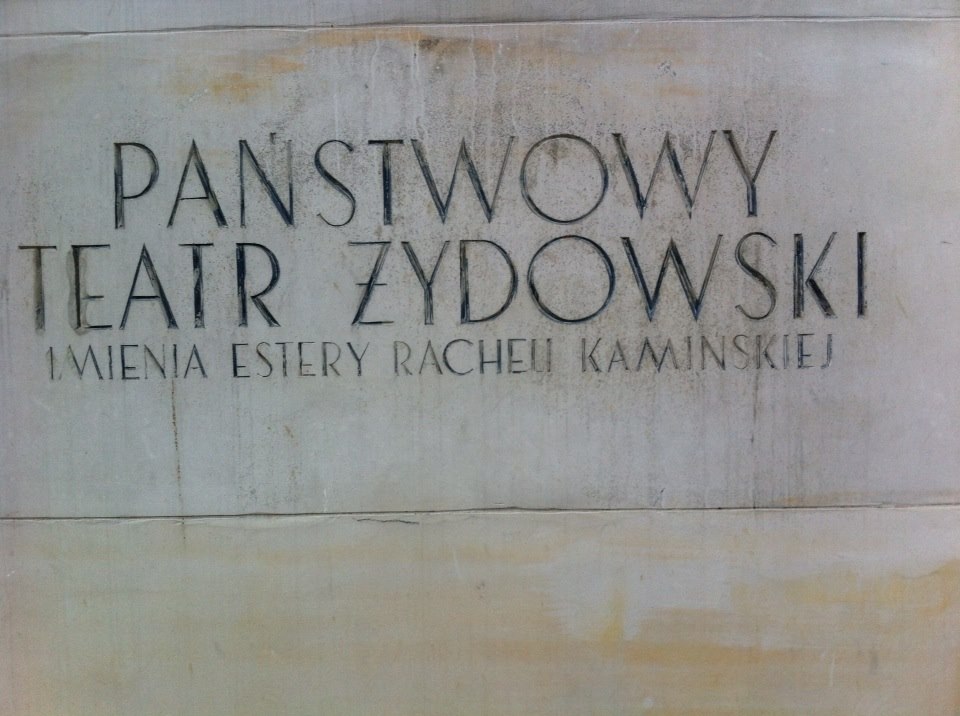
Sign for the Jewish theater
There were two young girls smoking and chatting, I asked them in Polish for directions. I found their answers in rapid Polish difficult to follow. They turned on the iphone maps and tried to guide me but actually took me out of my way, until we turned around and found the way. They then turned to English, which they spoke quite well, and apologized for not being of much help. I told them, no the contrary, "You have been a huge help and this has been a wonderful experience as you showed me how much you care", and with a very enthusiastic response one girl said "of COURSE".
Every smile, every act of kindness brings peace to our troubled world.
In the synagogue I found an interesting mix of people. A few locals, Polish Jews who did not look as I had imagined them, a group of American and Israeli kids, and three Hasidic Jews from Israel. The kind rabbi, an American, asked if anyone needed a place to eat.
I did not want to trouble anyone so I did not ask for a place to eat. But, Jewish hospitaltiy does not accept no as an answer and soon enough I was invited by the owner of Kosher Delight Poland to eat in his restaurant, for free, with other Jews.
I shared a table with two Hasidic Jews who as it turned out were the mashgichim, the Kosher supervisors. As we washed our hands I noticed that the towels were imprinted with the word "Ger" clearly referring to the Gerer Hasidic sect.
The Ger sect actually began in a little town called Ger in Yiddish, Gur in Hebrew and Gora in Polish. Today it is known as Gora Kalwaaria in Polish. I It was amazing for me to think that I am actually just half an hour away from the this legendary Jewish location. It is only 16 miles, or 25 kilometers from Warsaw, where I am at the moment. Hopefully sometime I will have the opportunity to visit there.
This Hasidic group numbered around 200,000 before the Holocaust, the Shoa. Very few survived, but among them was the father of my closest friend. I mentioned this to my Shabbat dinner companions and they told me that they and the owner of the restaurant are also Gerer Hasidim and in fact knew very well of my friends' father, a highly respected man in the Gerer world.
What a small world. Here I was in Warsaw enjoying a Sabbath meal with Gerer Hasidim, just a half hour away from where the group had begun.
After dinner I walked back to my hotel alone. I imagined how it must have been years ago on a Friday night; Jews in long coats would be outside discussing the Torah, Yiddish would be heard, many shops would be closed in honor of the Sabbath. But today....none of the exists. It went up in the crematoriums of Treblinka...
I walked home alone, alone with my thoughts, but in my mind I was being accompanied by spirits of those who once walked here, who were saying to me, "Thank you for not forgetting us".
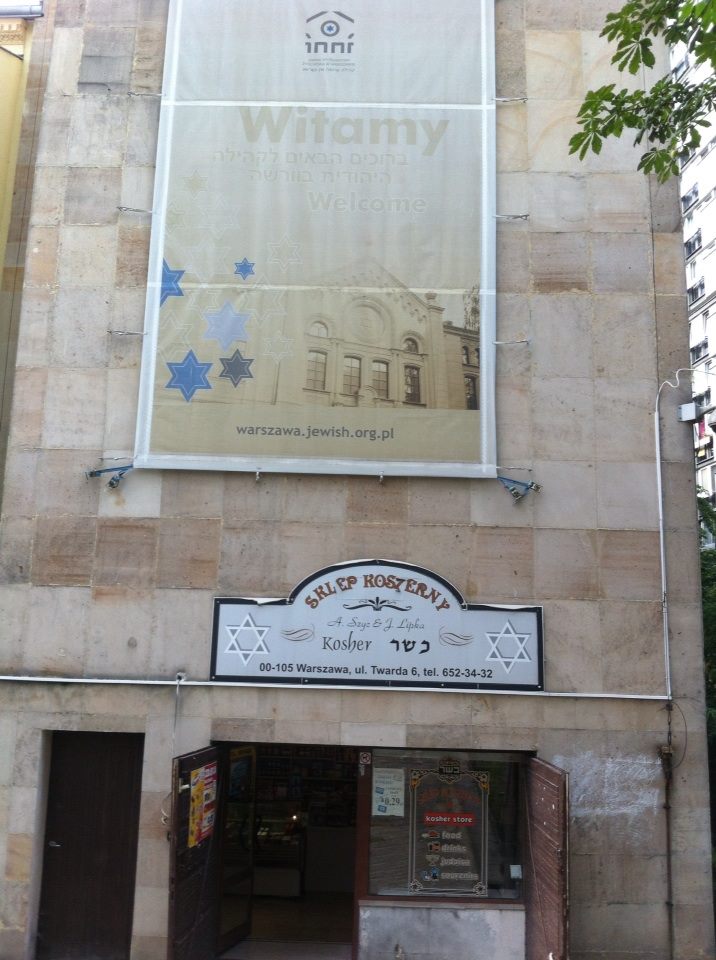
Signs of some Jewish "Revival" in Poland. The Kosher store.
So today I returned to pay my respects and take some photos. I was not the only visitor. Also taking photos were a large group of clearly Israeli girls. I asked them in Hebrew where they are from; from an Ulpana, religious girls school in the south. They asked where I was from; Maaleh Adumim. "Wow, she over there is also from Maaleh Adumim" as she pointed to another girl.
The young girl became very excited and was promptly told by other girls to calm down, "You get so excited every time someone mentions your town!"
Later a young girl comes up to me and says, "You are from Maaleh Adumim, you teach Karate!" "Yes, and now do you know?" Because I trained with you years ago." And we meet at the synagogue in Warsaw.
As I was leaving yet another group came, older people, also from Israel. I greeted them and by now it seemed that I was the official greeter to the synagogue. As Tomasz said, "You are at home here".
The old synagogue is not being abandoned. As my friend Tomasz said, "There are more people here than in a church!" He seemed truly amazed to see the Jewish commitment to our history; in the past few days we met young and old from the USA, South Africa, Israel and Australia, they all came here to pay tribute to our Jewish history in Poland, a land the Jews called home for more than 1,000 years.
It is always interesting to experience something from the eyes of another, he was seeing his city for the first time from my eyes, the eyes of a very very old Jew who feels the history deeply. I was seeing it from his eyes; total amazement that young Jewish girls came from so far away to visit Jewish Poland and show their respect.
The impact of Polish Jewry upon the Jewish world is still deeply felt.
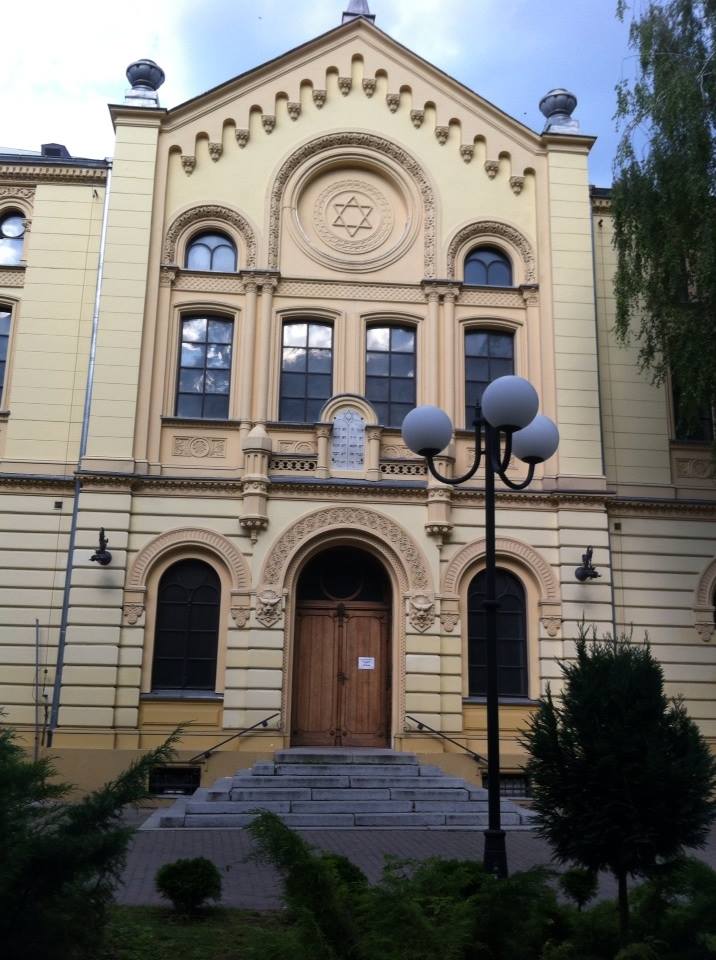
Nozyk Synagogue, Warsaw, Poland.
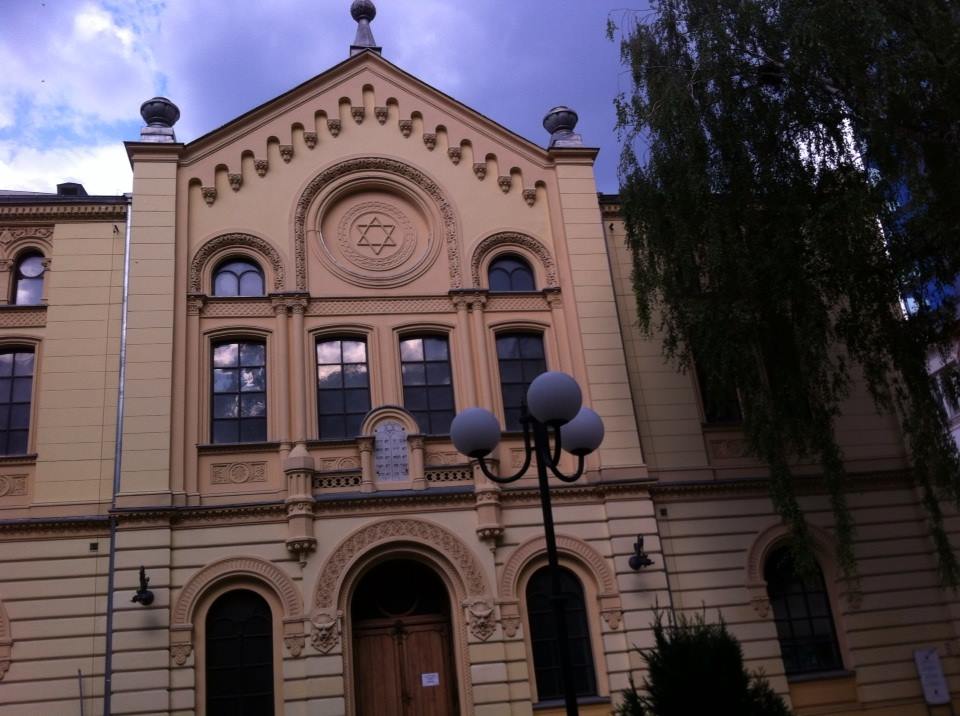
The Nozyk synagogue is said to be the only synagogue to survive the war. Although I have heard about a tiny hidden synagogue underground.
The Nozyk shul was build between 1898 - 1902 by Zalman and Rywka Nozyk.
The area it is in was part of the "Small Ghetto" and thus was not part of the Warsaw Ghetto uprising. Therefore it was not destroyed when the Nazis burned down the ghetto. Miraculously it also survived the devastation of Warsaw during the 1944 Warsaw Uprising which left the city in ruins.
The Warsaw Uprising
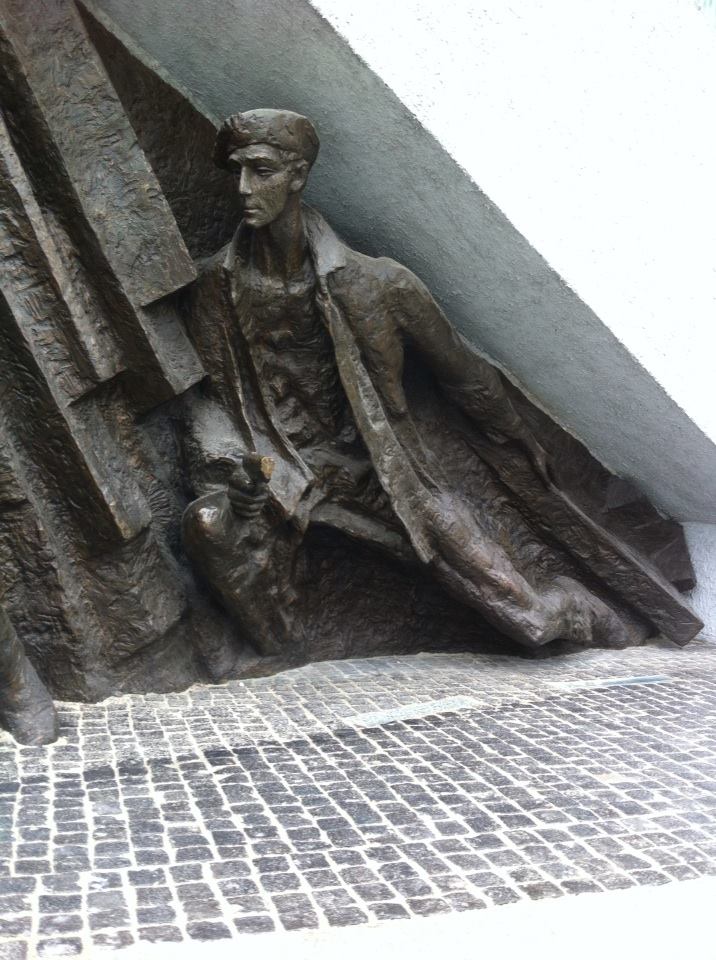
Most of Warsaw was destroyed during the Warsaw Uprising (powstanie warszawskie) which was the largest military effort taken by an European resistance movement during World War Two.
The uprising began on 1 August 1944, as part of a nationwide plan. The Polish people were expecting help from the Red Army but this did not arrive.
Initially, the Poles established control over most of central Warsaw, but without sufficient help from the Allies the efforts ultimately did not succeed.
Although the exact number of casualties remains unknown, it is estimated that about 16,000 members of the Polish resistance were killed and about 6,000 badly wounded. In addition, between 150,000 and 200,000 Polish civilians died, mostly from mass executions. Jews being hidden by Poles were exposed by German house-to-house clearances and mass evictions of entire neighborhoods. German casualties totaled over 8,000 soldiers killed and missing, and 9,000 wounded. During the urban combat approximately 25% of Warsaw's buildings were destroyed. Following the surrender of Polish forces, German troops systematically leveled another 35% of the city block by block. Together with earlier damage suffered in the 1939 invasion of Poland and the Warsaw Ghetto Uprising in 1943, over 85% of the city was destroyed by January 1945, when the course of the events in the Eastern Front forced the Germans to abandon the city.
The fighters goal was to establish a pro-Western, democratic-capitalist Poland. Today, after many years of harsh communist rule that goal has been achieved.
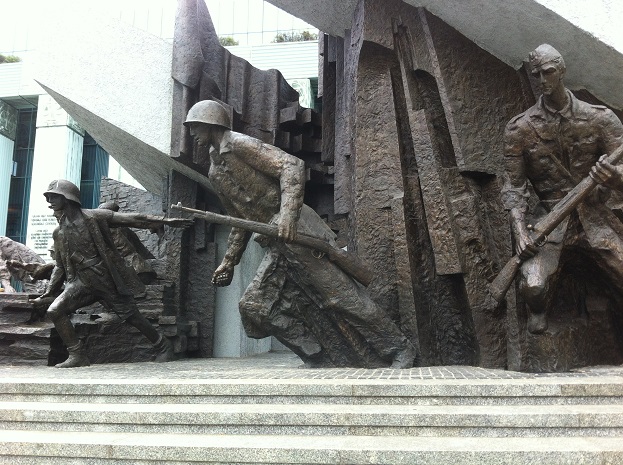
Huge larger than life monuments to the heroes of the Warsaw Uprising.
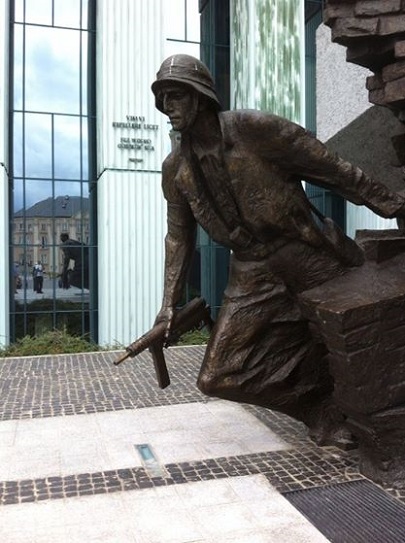
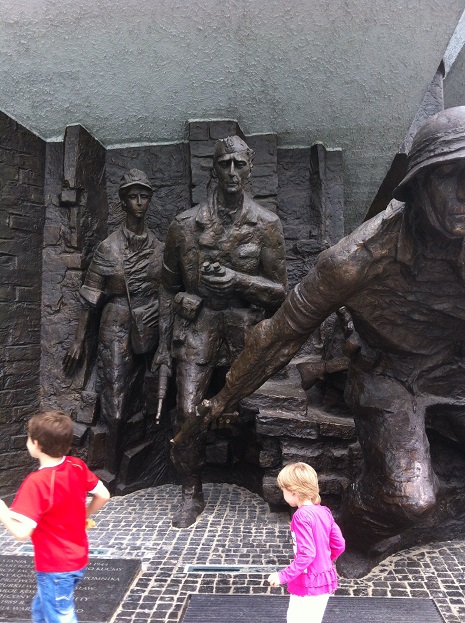
The present meets the past, young Polish children meet those who fought for their freedom.
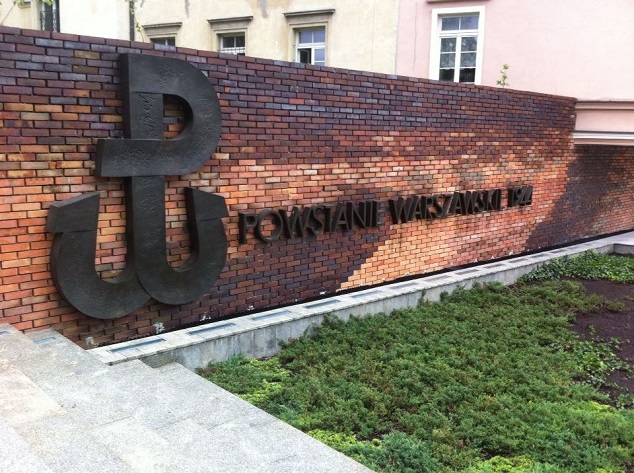
Memorial to the fighters of the Warsaw Uprising
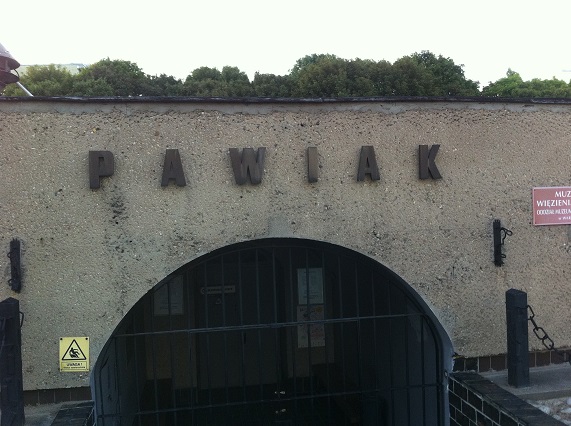
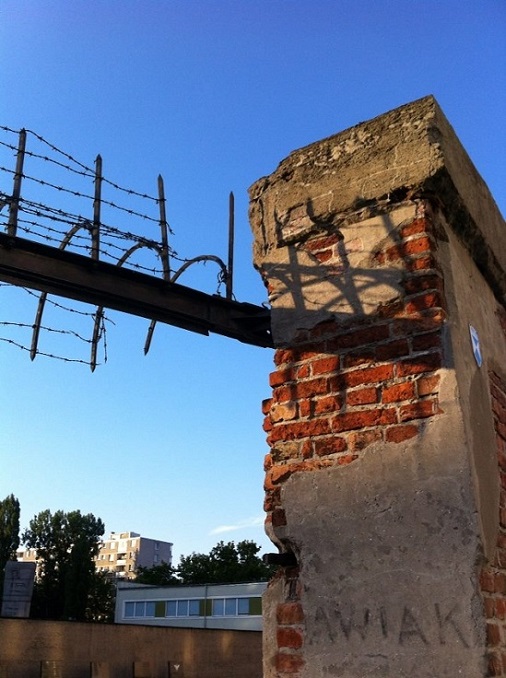
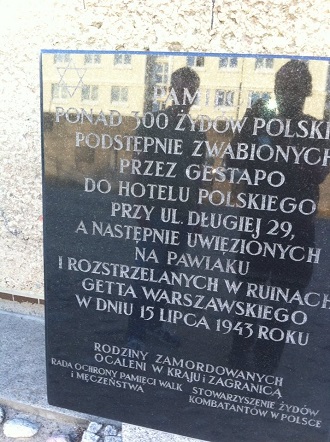
Warsaw Today
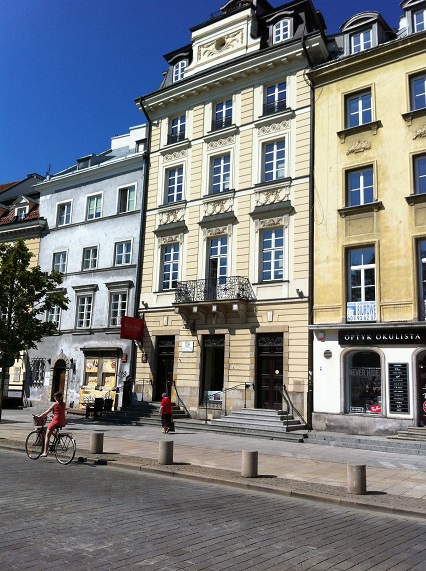
Warsaw today, these buildings are reminiscent of the style that existed at the time of the ghetto.
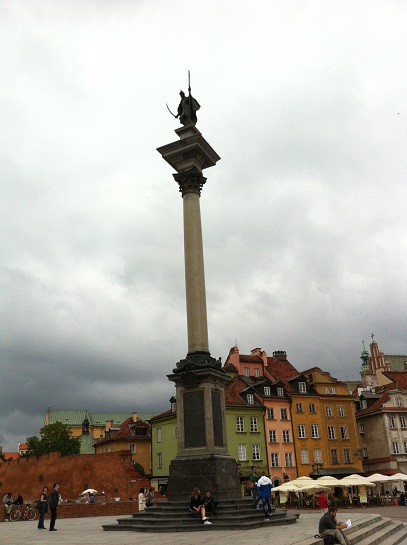
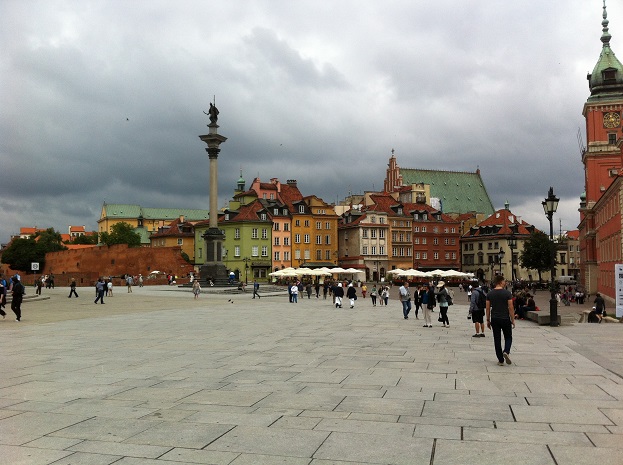
"Old Warsaw"
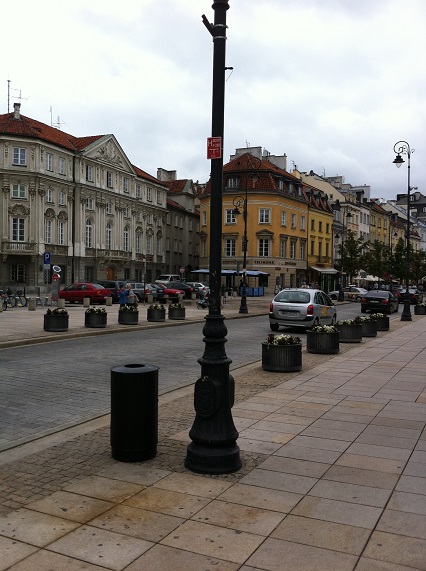
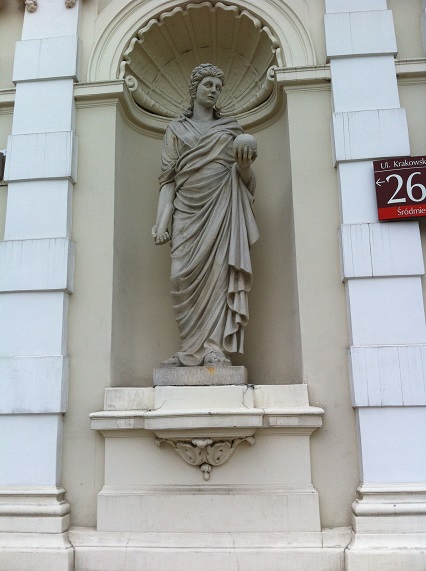
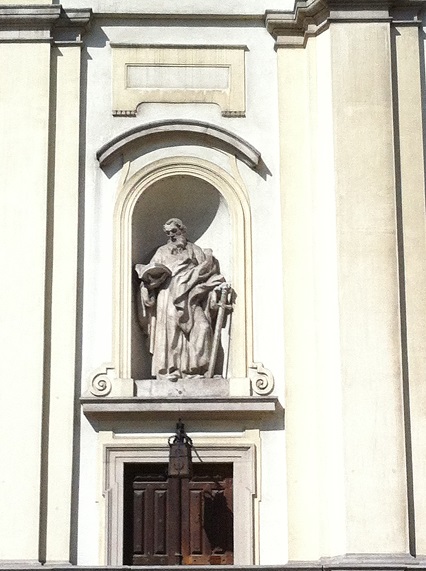
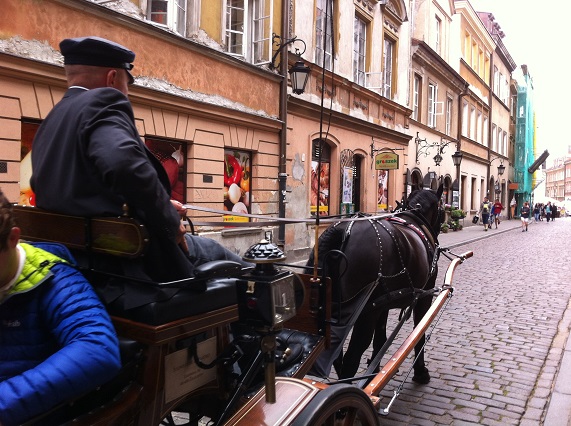
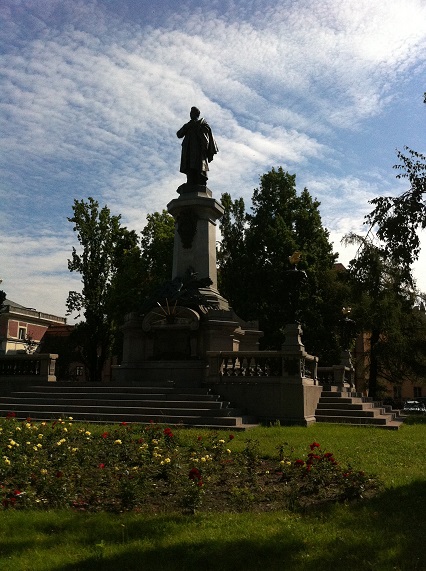
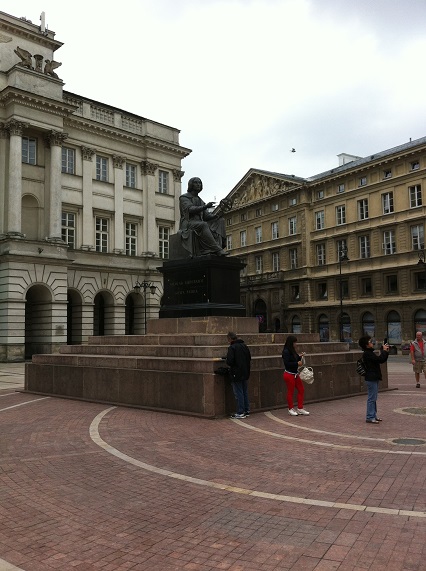
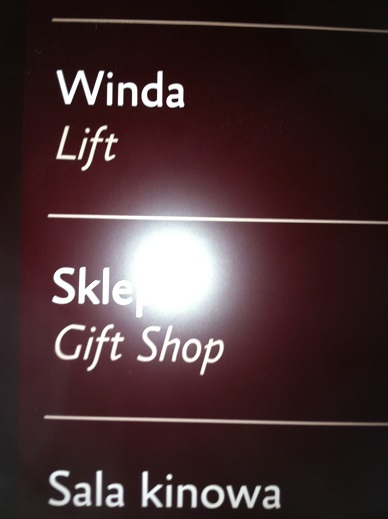
Time to learn some Polish.
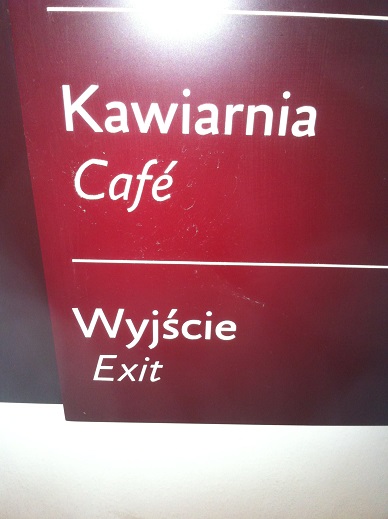
Essential Polish words
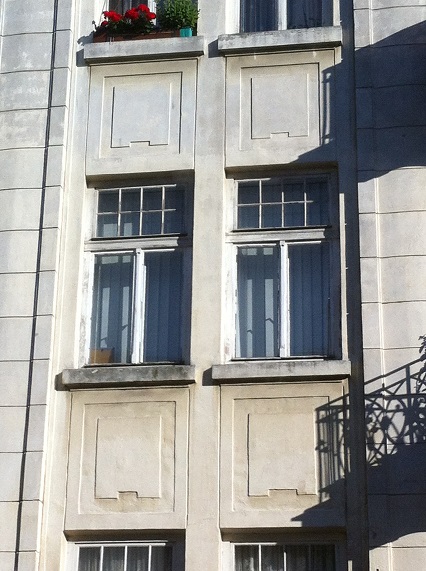
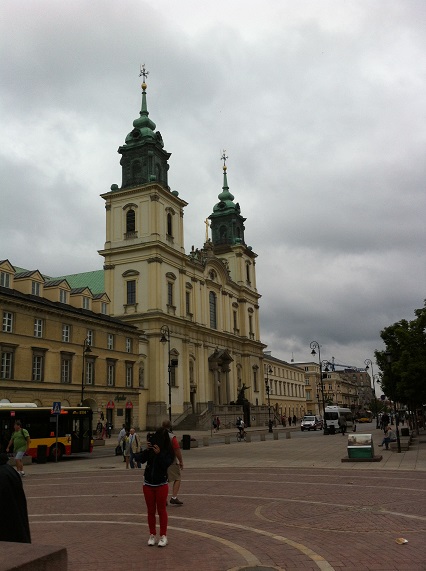

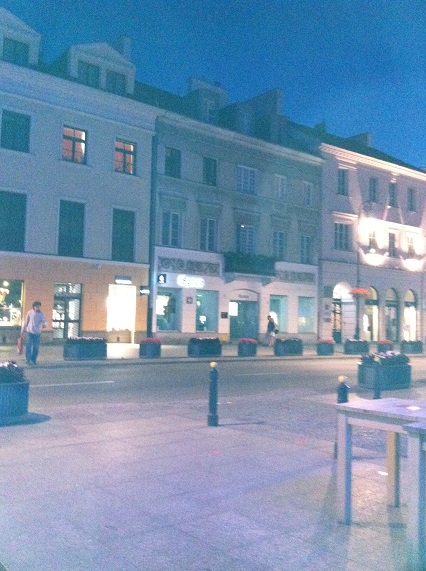
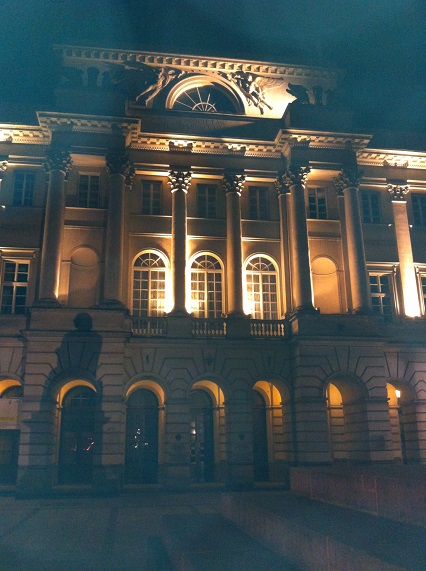
Warsaw at night, a beautiful city.
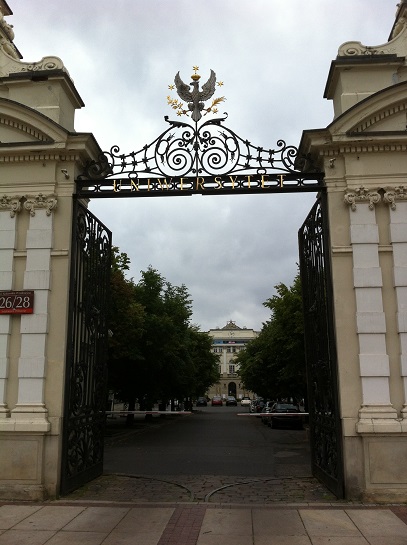
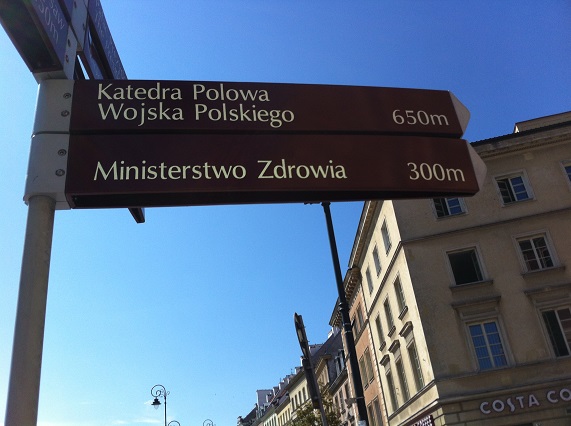
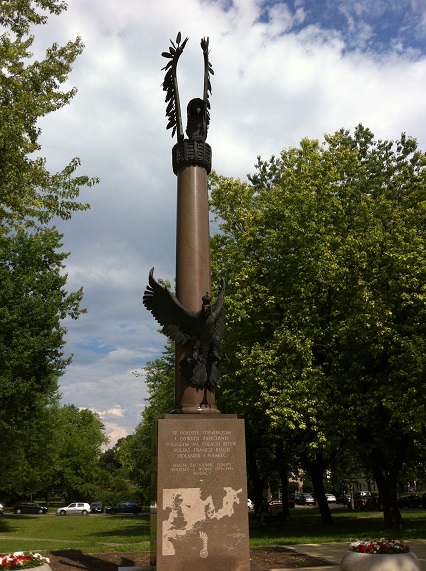
Memorial to Polish soldiers who fought around the world.
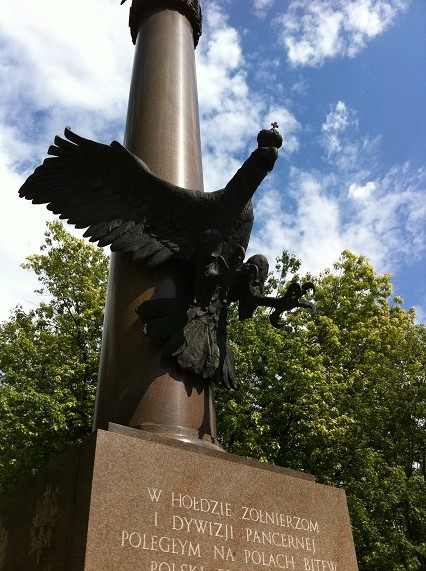
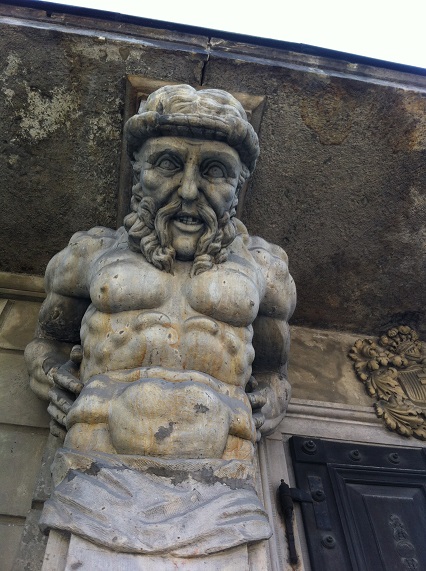
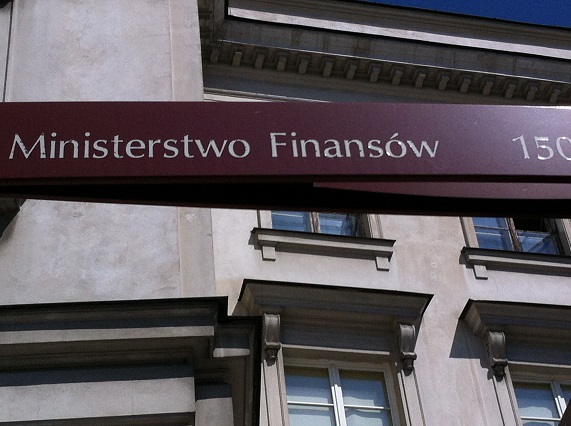
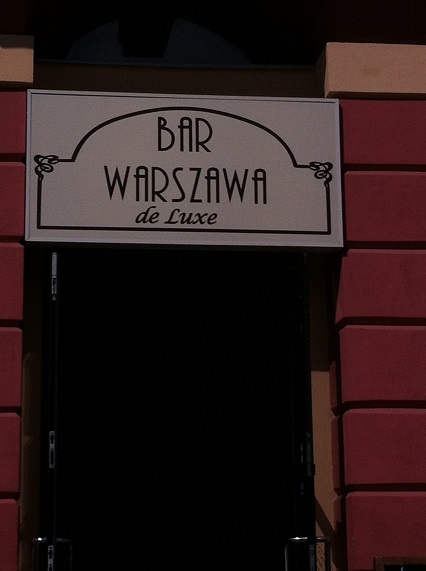
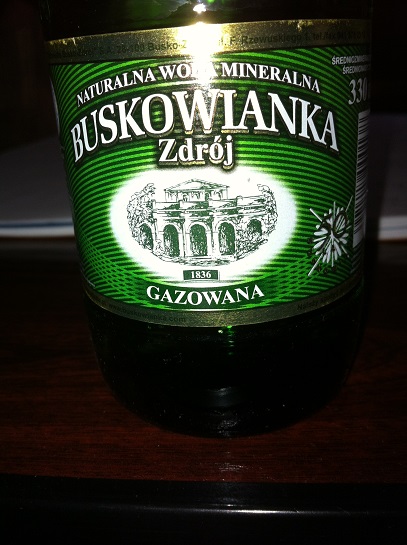
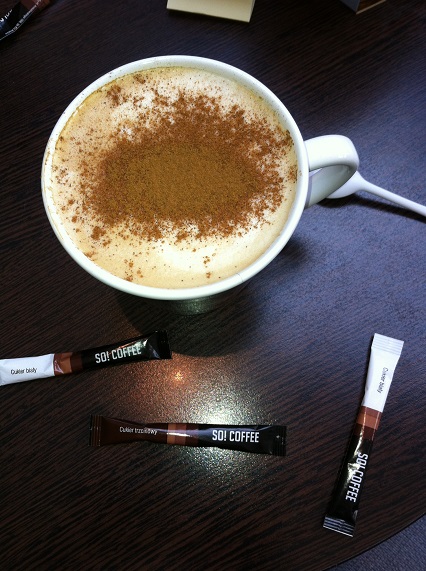
No blog is complete without coffee.